 USN Fleet Submarines (1942-46): 182 planned, 62 cancelled, 120 Completed (service until today), 13 navies
USN Fleet Submarines (1942-46): 182 planned, 62 cancelled, 120 Completed (service until today), 13 naviesWW2 US submarines:
O class | R class | S class | T class | Barracuda class | USS Argonaut | Narwhal class | USS Dolphin | Cachalot class | Porpoise class | Salmon class | Sargo class | Tambor class | Mackerel class | Gato class | Balao class | Tench classThe Balao class were a second class of emergency wartime fleet submarines derived from the Gato class, itself a near-repeat of the Tambor class.
They were modified with STS steel to dive twice deeper, and received all previous modifications of fairwater and conning tower to be more efficient.
The Balao accounted for a large part of the US submarine effort in wartime, destroying the Japanese merchant marine but a lot of the Imperial Japanese Navy, including IJN Shinano (largest CV until 1960 USS Enteprise).
The grand total for all three classes was 120 completed. Postwar, the Balao class, which for many in the late series saw little WW2 action (11 lost, twice less than the Gato), also made the bedrock of the “fleet snorkels” in the cold war US submarine fleet, converted as GUPPY.
They were also largely exported under MDAP to allies, for many more years of useful service in 12 navies.
See also the Guppy article for a follow-up. More addon-articles are planned in the future, such as the cruise missile variants and MIGRAINE program picket boats.
Development
1940 Emergency Program
From 1937 to 1940, the situation in the Pacific degenerated. War games pointing how the USN would fare against the IJN were not encouraging. So it was envisioned to built more submarines as they were seen as a potentially very useful asset in the Pacific, sparing surface assets for a possible war in the Atlantic, due to their long range and stealthiness. The Gato class was at first planned as an immediatez follo-up of the Gar class, but in a limited serie of six boats, like for previous classes. By January 1940 the Gato class was developed as the ultimate development of the perfect fleet submarine. USS Gato was ordered to Electric Boat in October 1940, USS Greenling and Grouper in November and December, Drum at state-sponsored Portsmouth NyD in Kittery, Maine by September, Flying Fish in December. The new serie started with Gato (SS-212) despite the fast she was launched later (21 August 1941) than USS Drum (SS-228, 12 May) and completed on 31 December, a few days before the attack on Pearl Harbor.
This programme gained new importance as the Pacific Fleet battle line was wrecked in Parl Harbor on the “day of infamy”, leaving three ships sunk and the rest badly damaged. This battle line was the pivot on which the USN depended for operations against the IJN, and with only aircraft carriers surviving, the other assets were submarine. Hence, this immediately marked the way operations were done. Battleships took the back seat, submarine and air power took the operational lead, front and center. This disappearence of battleships also wrecked the concept of submarines acting as “fleet scouts”, a belief forged over 20 years of submarine strategic doctrine, notably as a concession to the the “old guard” still believing in Mahanian concepts and opposed to both aviation and subs. Commander Lockwood, soon at the end of the US submarine arm in WW2 also had to oppose another faction in the USN that believed submarine were only useful for coastal defence (a bleif shared by many admirals including before WWI, confirmed U9 rampage in the channel). Now at war with Japan, Lockwood convinced board that these submarines, far to have no purpose, were still superbly qualified for a new mission: Commerce raiding against the Japanese Empire.
From the six Gato classs initially planned FY41, the Two-Ocean Navy Act 48 saw an order for 33 more Gato, plus yard previously unused to these contracted, such as Mare Island Naval Shipyard in Vallejo and Manitowoc Shipbuilding in Wisconsin. Together, they produced 77 Gato class subs over 1942-43, the last laid down in May 1943, completed in March 1944. Standardization and simplifications plus a new shipbuilding organization led to shorter construction times in less than a year and down to nine months in some cases, which enabled the very large number of the Balao class to be built, 120. Indeed, as the Gato class construction progressed and early reports piled in, many ideas emerged on how to improve the class.
Design
Design Genesis
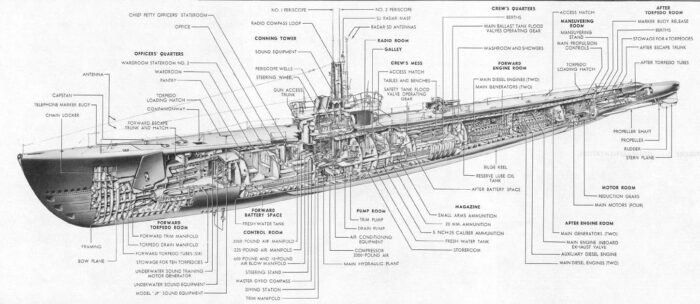
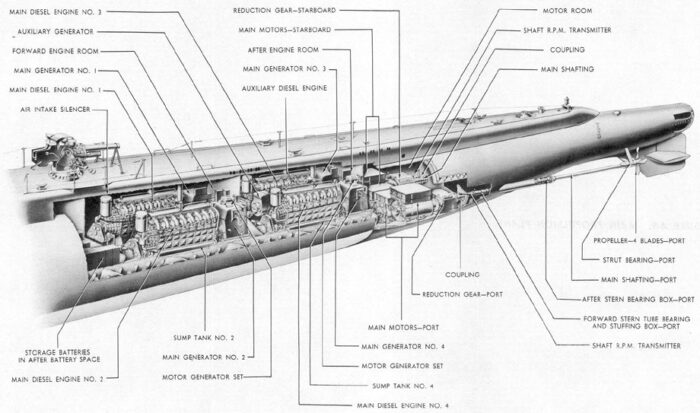
Line drawing of the General Arrangement of the USS Balao SS-285, courtesy of Lester Palifka, declassified ONI documentation via navsource.
The Gato, and the Balao and Tench class submarines were esentially the same, entirely based on the 1939 Tambor class design, built in 1939-40. The latter was indeed estimated as the best possible design for a “fleet submarine” in the doctrinal type envisioned to work with a battlefleed, so capable of 21 knots (39 km/h) in reliable conditions, which was their own range, and 11,000 nautical miles to accompany them. Indeed, fleet destroyers such as the Clemson/Wickes and successors were limited to at best 5000 nm. This range unlocked to them Japanese home waters, a very distinct advantage, notably compared to smaller European submarines. To compare the common Type VIIC fielded by the Kregsmarine was unable to reach the US coast, despite being close than the Japanese home islands. Only the Type IX could.
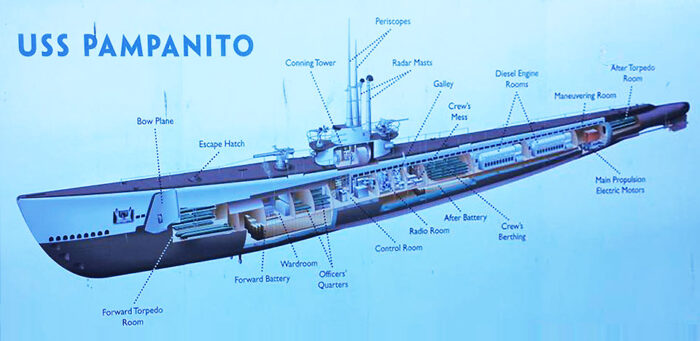
Scheme of USS Pampanito (SS-383)
So these new fleet subs were able to reach distant operational areas in an autonomous and sicreet way, with six bow torpedo tubes, two at the stern and a reserve of torpedoes. The design included a “central operation” below the conning tower for improved combat operations. All main operators were under dirtect control of the captain and XO, and in addition the Tambor had a new fire control system with a ballistic computer for targeting calculations and improve accuracy. In short, the Tambor was “close to perfection” and the next design of late 1939 saw minor improvements.
Differences between the Gato/Balao and Tambor

Tambor, Gatos and Balao class boats were very close in design, and through their wartime modifications they became almost indistinguishable. Still, the early Gato class batch compared to the Tambor and Gar had stepped shears for theit CT periscopes fairing, in twin fairlead or bullnose forward at the prow. Portmouth NyD had ring-type bull nose towing fairlead at the very tip of the bow unlike EB boats which had limber holes plus a Curved and then horizontal bulwark, and superstructure ending short of the stern. Small set of limber holes were also imprpved on the Balao class. In periscope shears, it went from two 40-foot periscopes, with a periscope station in the control room to a Gato class having a lower first periscope eyepiece and shorter shear support.
Hull-wise, the Gar/Tambor were five feet shorter (1.524 meters) due to the fact all four main engines and generators were contained in a single large engine room, unlike the Gato and Balao which engines were in separate rooms closed by watertight bulkheads. On the previous boats this really was a safety issue in case of flooding. Electric Boat type of fairing to the bull nose towing fairlead into the superstructure was kept on the Balao as well as the superstructure aft ending short of the hull, repeated also on the Tench class.
The Balao class like the Gato-class design kept their formidable 11,000 nautical miles (20,000 km) radius, but the hull was a bit stronger for deeper dives, from 250 feet (76 m) to 300 feet (91 m). Construction still called for a partial double-hulled construction with an inner pressure-resistant hull wrapped by an outer, hydrodynamic hull. Voids between the these provided extra space for fuel and ballast tanks. The outer hull merged with the pressure hull at both ends, forward close to the torpedo room bulkheads so it was still considered “partial”. Naval architects and engineers at the Bureau of Construction and Repair (BuC&R) believe they had been unduly conservative in their estimates of hull strength. Thuse, thickness of the pressure hull steel was unchanged apart extra reinforcements. This 50-foot (15 m) increase in diving operation meant a crus depht below 600 feet or 180+ meters.
Main differences between the Gato and Balao
Diving deeper
The Balaos were similar to the Gatos essentially, but were modified to further increase test depth from 300 ft (90 m) to 400 ft (120 m). By late 1941, two of the leading submarine designers, Captain Andrew McKee and Commander Armand Morgan, met to find a way to make the Gato clas dive deeper, even if this included a more thorough redesign. The first major step was to saw the traditional steel used for hull construction to a new High-Tensile Steel (HTS) alloy also now used in aircraft carrier construction. Combining it with an increase in hull thickness, from 9⁄16 inch (14.3 mm) to 7⁄8 inch (22.2 mm) gave a theoretical test depth of 450 ft (140 m), crush depth of 900 ft (270 m), the same as U-Boats. This wa smore than twice the theoretical crush depth of the Gatos, an enormous improvements as far a safety went. The Japanese, which just developed their weak ASW capabilities at the time knew nothing of this. This became an USN tightly guarded secret as indeed, the Japanese would not have setup their depth charge for such deep setting at the time… Until this “secret” was made public (see later).
The only limiting factor in this new advantage was However, the limited capacity of the trim pump at deep depths. There just was no time to design a brand new pump capable of dealng with this pressure, so Rear Admiral E. L. Cochrane, Chief of the Bureau of Ships (BuShip), decided to just limit test depth to 400 ft (120 m) like the Gatos. Captains which went from Gatos to Balaos knew of the amazing resistance and their hulls however and even knowing the limitation of their pumps, tried to find workarounds. Fortunately at least by 1944 a redesigned Gould centrifugal pump replaced the earlier noisy early-war pump. From there, all captains had this option of diving much deeper at hand, a game changing asset to survived fierces ASW attacks as the Japanese in between had considerably ramped up their own game. This saved many lives without a doubt and this is reflected in the fewer losses of the class compared to the Gatos, despite far more were actually built: 11 losses/120 versus 20/77 so approx. four times less.
Reworked Fairwaters and Conning Towers
The other advantage of having Gatos and Tambors already in service from December 1941, led to adopt their own modifications of the fairwater, conning tower and periscope shears. All were reduced in order to accelerate diving times and made the boast generally quieter and more discreete while under persicope depth, more difficult to spot. These efforts, improvized in yards at the first refit, were thus retrofitted to the Gato design. They benefited along the way during construction over two years, of all reductions of the sail, to the smallest practical size. The first Balaos were indeed launched, when the first patrol lessons led to rework the design of the bridge and sail. They proved to be far more efficiently laid out, better equipped, and much liked by the crews.
The Balao’s masts and periscope shears original arrangement for Government and Electric Boat designs saw now two tapered cone shaped periscope support shears, a thin mast for the SJ surface search radar, and thin mast for the SD air search radar from forward to aft. Minor differences in the way periscopes were braced against vibration distinguished Balao class boats in time and between yards but they were nearly identical in general.
Halfway through their production run, Electric Boat altered the design of the Balao class to move the SJ radar mast forward of the periscopes, and then enlarged the SD radar mast. Later in the war, early Balaos were refitted and saw their SD air search radar moved slightly aft, and placed onto a thickened and taller mast. These mast arrangements and numerous variation in gun layout made for still very diverse exterior detail difference in class and just the Gatos, Balaos ended all singular in appearance despite the wish of the Navy that wanted standardization. Captains while in refit took advantage of whatever assets were at hands to equip their boats the way their intended to use them. This is very much reflected in the armament, see later.
Hull and Ballasting







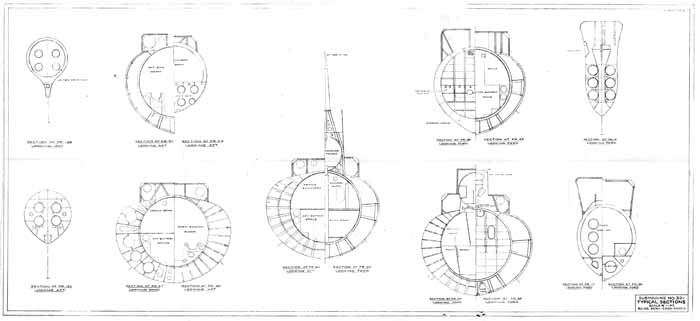

Plans of USS Roncador, SS-301, src below
The Gatos like the Balaos had about the same double-hulled configuration, with a pressure hull surrounded by a second non-watertight hull containiun fuel, oil tanks, ballast, and trim tanks for diving and surfacing, with their repsective pumps blowers. Only the new steel was a main difference but the arrangement remained essentially the same. The outer hull could be accessed in case of using storage (mostly the upper outer hull, below the flat deck) but this was still a very restrictive space. Storage was wrapped in waterproof tarps below deck. It was easy to dismount deck panels indeed. They were in steel aft and forward, but there was the same wooden “cigarette deck” made in teak on the central portion, painted black, where the deck gun was located for easier stepping. Water rushed in between interstices but the appearance was not about the name of “cigarette deck”, rather just its use when sailors were pausing while surfaced.
The central section of the pressure hull was externally-framed and cylindrical, made as seen above of STS steel of 0.8 inch (22.2 mm) instead of 14.3 mm (0.56 inches) 12.5 kg/M2 untreated steel. Like for the Gatos, the two end compartments were truncated conical sections and the conning tower presented a conical cylinder fitted on top of the main pressure hull and above the control room with a fairing around. The diameter of the pressure hull changed in a minor way due to the STS hull, but remained overall at 16 feet (4.9 m). The deck and shaped hull tailored for 21 knots was kept unchanged. The forward deck casing still comprised the same anchors (under recesses on both sides) a capstan, forward dive planes, and a buoyancy tank. The deck was also strengthened forward and aft to install up to two 3-inch, 76.2 mm deck guns or heavier. The choice of having a single gun if large, was a question of stability. No captain would responsibly install two 5-in/25 guns for stability issues.
Deck and CT
The deck casing above the pressure hull leaving water entering also trapped air, making noise, bubbles, and for a slow diving time, so the generous limber holes cutout at its sides notably the efficient half moon at its base were now standard on the Balaos. The conning tower fairwater structure no longer had an enclosed bridge and the conning station was reduced, followed the Mo 1-3 Gatos pattern (see below). The “cigarette deck”, initially covered with teak on the Gatos was changed for anti-slip steel instead, as supply of Teak understandably ran dry. This steel was a lowe grade-soft type that could be produced in large quantiotoes, notably from foundry leftovers. It’s clear that the Balao did not kept their initial pintle mount for two Browning AA HMGs. The 20 mm Oerlikon was indeed available since at least 1941 at the time when completed: USS Balao herself (completed 4 Feb 1943). In fact in mid-1943, single mounts started tio be replaced by twon mounts, so all boats could have a baseline battery of a 40 mm Bofors, two 20 mm Oerlikons, and deck gun (see later).
Detailed design
Forward Torpedo Room:
The six forward torpedo tubes were located in the bow, four reachable by removing the deck plates. At the start of any patrol, there were torpedoes in each tubes plus a reload each for the two lower tubes stored below the deck plates, two reloads for each of the four upper tubes for a total of sixteen. The sonar gear was raised, lowered, rotated from its compartment as was the pitometer log, and the same compartment hosted fourteen bunks, moslty torpedo operators.
Forward Battery Compartment:
Half of the 252 battery cells were located below the deck plating in this compartment. Above was located the officers’s wardroom, and a dedicated gallery where their food was prepared, they ate separate from the ratings. There were three compartments where the officers were berthed in 4-men or 2-men cabins and one solo for the captain. One compartment was for three junior officers. The executive officer (XO) and first lieutenant shared one of these compartment. The captain had the only private space on board, and a dedicated attendant and caterer. The five senior chief petty officers shared a fourth compartment. Some boats sailed wiuh ten officers when acting as wolfpack flagships. The yeoman′s office was also there, receiving reports and logbook. Neaby was the the officers′ shower and head as well.
Control Room:
Located at the center, it comprised the steering and depth was control operations. The Hull Opening Indicator Panel, (“Christmas Tree”) displays red and green lights for every opening in the pressure hull. Flooding or blowing was controlled also there. Below it room was the pump room with the backup compressors and radio shack was at its aft end.
Conning Tower:
There was a reduced cylindrical compartment above the control housed by the fairing structure. Both periscopes (attack and watch) were operated from the conning tower. The first Gato possessed a Type 2 attack or (“needle”) periscope with a reduced profile not to be spotted, and faired not to create a wave. The large one was the Type 3 search periscope, with a broader angle and better scope giving bearings. From 1944, the Type 4 “night” periscope replaced the Type 3, fitted with a primitive system: It admitted more light but had a shorter tube so less light was dispersed, and incorporated an ST range-only radar for submerged night attacks. The Torpedo Data Computer, same as the previous Tambor class, was on the port bulkhead aft (expect an upgrade on later models). There were operators for the surface search radars and active sonar displays, and secondary steering position. Repeaters for all gauges were also there. In addition to the captain and XO in an attack were were often two operators, two radar and sonar operators, and talker, repeating orders at loud.
Aft Battery Compartment:
The remaining 126 battery cells and main magazine were located beneath the deck plating, there as well as the main pantry for the crew, freezer, and refrigerated food storage. Above it was located the small medical locker, crew′s mess, galley for ratings and men and 36 individual bunks. Their showers and head were at its aft end close to the washing machine and small storage lockers for valuables items. This is the largest compartment.
Forward and After Engine Rooms:
These were basically identical, separated by a fireproof, waterproof bulkhead unlike the Tambor class. Each contained two of the four main diesel engines. They drove each a 1,100 kilowatt electrical generator to charge batteries and/or drive the electric motors, a flexible system. However the heat inside this compartment was quickly unbearable, if the air conditioning failed. For the anecdote, the excellent Fairbanks-Morse were derived from Junkers Jumo engines and adapted to diesel oil. The GM engines had two banks of eight cylinders running at 750 rpm. The Fairbank Morse engines came in nine-and ten-cylinder versions using opposed-piston running at 720 rpm. They were by far, the most reliable diesels in US submarine history.
Maneuvering/Motor Room:
In this were located the four electric motors rated for 1,350 hp each along with two sets of reduction gears connected them to the propeller shafts, below the deck plating. Switch panels controlling these motors and gearboxes were located above the deck, in the “maneuvering room”. These electric motors ran at a constant, high speed and it controlled by the Westinghouse gearboxes, which were derived from standard automotive transmission.
After Torpedo Room:
This compartment housed the remaining four torpedo tubes with eight torpedoes total, four in tubes, four spares on skids. There were the last 15 bunks for torpedo crews, and the bosun′s tool locker. However later in the war, with extra AA and systems, the crew grew often to eighty men and the return of the practice of “hot bunking” depnding on quarters. Some bunks in the torpedo rooms couldn′t be lowered due to the reloads.
Internal Improvements and equipments
The Balao class repeated the Gato’s new “crew comforts” to alleviate the two months of patrol with a 60-strong crew. Considered still by some in the Navy as “undue luxuries”. They had extra showers, a good air conditioning, refrigerated storage and generous freshwater distilling units at several locations on the boat, plus clothes washers and bunks for almost all individual crew member. And since alcohol was prohibited in the USN (unlike in the RN, with sometimes dodgy wartime exchanges of rum between allies), there was instead, like in the all USN ships, an ice cream dispenser. These were virtually unheard of in other navies to say the least, added to the fact food was on purpose made better than in the surface fleet. All these took part in boosting morale, adding to a generally stronger esprit de corps, not only for the smaller crew, but between submariners in general.
The designers of the class, initially felt that if a crew of 60–80 were expected to conduct 75-day patrols in the warm waters of the Pacific these were also essential to keep health and efficiency for the crew, and that was facilitated in the extra five feet or 1.5 meters in the hull. They could be added without impact to its fighting abilities and make an enormous difference. The air conditioning was also a safety feature. Indeed if a submarine submerged for any length of time, the heat generated by the shut-down diesels and electronic gear, plus human warmth all would rapidly raise internal temperatures above 100 °F (38 °C), compounded by high humidity already present in these tropical waters, condensating, dripping into equipment and causing electrical shorts, even fires. So the Air conditioning system acted as a dehumidifier, and also greatly increased general reliability. It ended as a vital equipment than all navies wanted post-WW2.
Propulsion
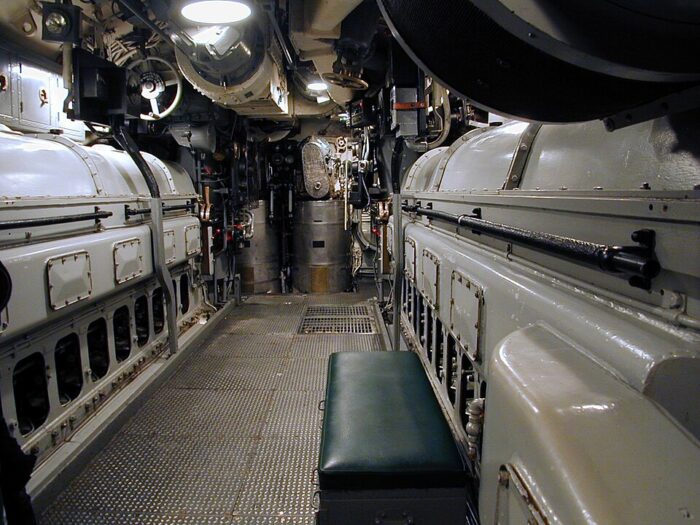
Fairbanks-Morse Model 38D8+1⁄8 diesel engine
The propulsion of the Balao-class submarines was generally similar to that of the Gato-class, as true diesel-electric submarines with four diesel engines powering electrical generators, and electric motors driving the shafts. This was an arrengement bringing much more safety and flexibility in operations. There was indeed no direct connection between the main engines and the shafts, and so less risks of loosing propulsion in case of a server depth-charging. This also reduced vibrations.
The Balao-class submarines also received either General Motors Cleveland Model 16-278A V-type diesels or Fairbanks-Morse 38D 8-1/8 nine-cylinder opposed-piston engine depending of the yard and availability. Fortunately, no Balao class was ever fitted with the disastrous Hooven-Owens-Rentschler (H.O.R.). Twelve Gatos receiced them as other engines were in short supply, and replaced at the first occasion. Experience widely prevented any of the Balaos to ever be fitted with these units, very promising on paper when sold to the US DoD (in short, twice the power on half the wieght and size of traditional diesels) back in 1937, but made with loose tolerance and poor assembly among others. The engines in service just tore themselves apart. There were exceptions though: USS Unicorn (436) and Vendace (430) were to receive these infamous Hooven-Owens-Rentschler (H.O.R.) diesels still on stocks, but both were fortunately cancelled.
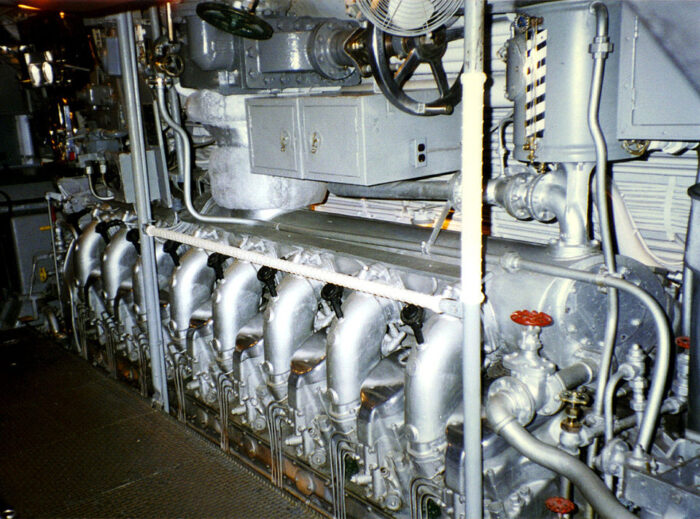
General Motors Cleveland Model 16-248 diesel engine
The General Motors Cleveland Model 16-248 V-type of the two, were not the best, but still far above and beyond the HOR in reliablity. These were the standards for early batches, until boats built from USS Sand Lance onward (SS-381). The latter indeed received 10-cylinder engines. Earlier General Motors boats received these retofitted Model 16-248 engines, but from USS Perch (SS-313) they obtained GM 16-278A engines. These new diesels had greater displacement albeit rated at the same power, just operating at a lower mean effective pressure, which greatly benefited reliability as they generated less vibrations. The Fairbanks-Morse and General Motors diesels were alltwo-stroke cycle types.
Electric motors for the Balao class came from Elliott Company motors, when generally coupled with Fairbanks-Morse engines. Instead, General Electric motors were fitted primarily to boats with General Motors diesels, as they were sold by the company as natural matching pairs. There were exception though and some Fairbanks-Morse boats had General Electric motors given discrepancies in supply, to not slow down completion. A thord type, Allis-Chalmers elvctric motors were to be used in SS-530 through SS-536, but all were cancelled.
These four high-speed electric motors, two per shaft, had to be fitted with reduction gears to slow their outputs down, down to the appropriate low-rev speed for shafts to say out of troubles. These reduction gearing were very noisy however (decribed at high regimes as almost “sreaming” sounds), making these boats easier to detect with hydrophones. Eighteen late Balao-class thus received low-speed double armature motors, driving the shafts directly, much quieter. This was not standard until the next Tench class. These new direct drive electric motors were designed by the Bureau of Ships’ electrical division, led by a certain Captain Hyman G. Rickover of cold war fame (the father of USN Nuclear submarines). The first equipped with these new systems was USS Sea Owl (SS 405).
Armament
With eight tubes, 24 torpedoes, the Balao class, like the Gato and Tambor/Gar retained one of the heaviest armament of any submarine at sea in WW2. It was theorized by engineers that more, up to 30 could be carried, provided the six extra ones were carried in unusual places difficult to access, like the uppoer outer hull, under deck space. It cause however a stability issues. Previous designs with torpedoes carried in vertical bins was deemed unrealistic. There was so much time a surfaced submarine could stay that way in enemy waters without danger, especially before good radars were available.
Of course, like the Gato class before them, the Balao were given “by default” the new Mark XIV torpedo, which proved a hinderance in early operations. However in early 1943, the Mark 14 issues had been partly fixed already, and completely by late 1943 and early 1944 while in betwee, captains took radical measures like removing their magnetic proximity caps for older contact caps, or swapped to older stocks of Mark X still around. Still, some early patrols had their fair share of frustration, but for their immense majority, Balao class operated without much torpedo issues, as the “Mark XIV battle” already had been won by Tambor/Gato captains.
Mark 10 Torpedoes

These boats were capable of firing the 21-inches Mark 10 21″ (53.3 cm) Mark 10, a 1917 design entering service in 1918. From 1927 these were the Mod 3, last designed by Bliss and manufactured by the Naval Torpedo Station at Newport. They equipped the WWI R and S boats, most V Boats, The Cachalot, Porpoise and Sargo, but were not intended for the Tambor class. They soldiered on in World War II still, as a trusted straight course in replacement for the infamous Mark 14. Before the latter had its defaults ironed out in 1942-43, the Mark 10 was in high demand and stocks starting to dwindle down rapidly. Thus, production was maintained until 1943.
⚙ specifications Mark 10 Mod 3
Weight: 2,215 lbs. (1,005 kg)
Dimensions: 183 in (4.953 m)
Propulsion: Wet-heater
Range/speed setting: 3,500 yards (3,200 m) / 36 knots
Warhead: 497 lbs. (225 kg) TNT or 485 lbs. (220 kg) Torpex
Guidance: Mark 13 Mod 1 gyro
Mark 14 Torpedoes
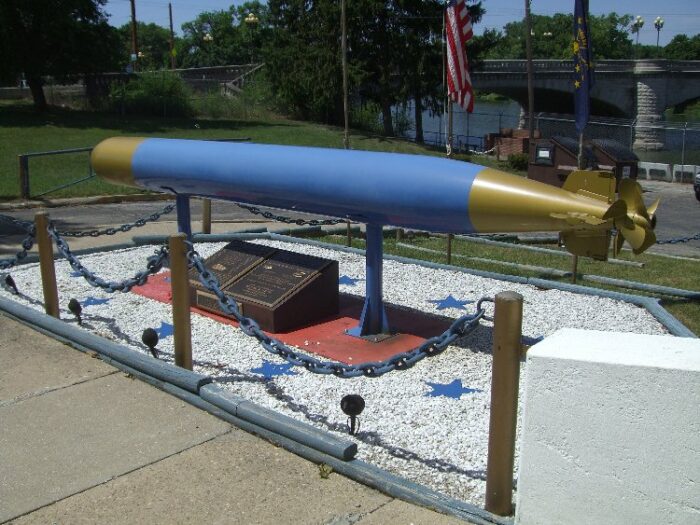
In 1941 she carried the Mark 14, entering service in 1930. Designed replacement for the Mark 10, this was the new standard. Unfortunately the model was infamous for its legendary unreliability, explaining the poor results obtained in 1942 and until mid to late 1943; Long story short, the Mark 14 was a revolutionary new model that was tailored to use a gryroscope combined with a magnetic pistol. The principle was not to detonate on impact, but use magnetoc proximity of the enemy hull to explode ideally under the hull of the target. This way, it was easier to break its hull instead of just making contact below the waterline. These torpedoes were designed at the Naval Torpedo Station Newport, Rhode Island from 1930 and considered state of the art, benefiting from a $143,000 budget for its development.
Production was pushed forward after testings, and at 20 ft 6 in (6.25 m), it was incompatible with older submarines’ 15 ft 3 in (4.65 m) torpedo tubes, like the R and O classes. It was also the best performer, capable of 4,500 yards (4.1 km) at 46 knots (85 km/h). Lots of promises, but the war proved that testings had not been thorough and the rate of misses compared to the Mark 10 became obvious in reports in 1942, this infuriated many captains that disabled the magnetic pistol, but did not solve the problem as it was proved later that their too fragile impact fuse was also faulty.
Responsibility lied with the Bureau of Ordnance, which specified an unrealistically rigid magnetic exploder sensitivity setting while not providing enough funding to a feeble testing program. BuOrd had a hard time later accepting it and enable a new serie of tests, which were mostly from private initiatives.
Only by late 1943 and early 1944 most problems had been allegedly fixed, so that the 1944 Mark 14 at least allowed captains to claim far more kills. The “mark 14 affair” sparkled a lot of controversy postwar and it’s not over.
Mark 14 issues:
The Gato like the Tambor class were of course given the promising new Mark 14 as standard when completed in 1940. They had an abysmal record and ushered in a storm of captain’s protestations in upper echelons, which coupled with the stubborness of the Ordnance delayed the issue to late 1942, mid-43, when their numerous issues were fixed. There were still stocks of the older, straight course contact fuse Mark 10 aplenty, which were “pillaged” every time they were available on forward deployment zones. The problem was that Mark 14s had been provisioned to the frontline, notably from Guam and Midway, so fustrated captains had to make due with these. Frustration amounted as detonations were often heard, but the warheads seldom exploded in a useful way, prematurely quite often or too low under the keel to do any damage and many alleged “kills” in 1942-43 were debunked postwar.
⚙ specifications Mark 14 TORPEDO
Weight: Mod 0: 3,000 lbs. (1,361 kg), Mod 3: 3,061 lbs. (1,388 kg)
Dimensions: 20 ft 6 in (6.248 m)
Propulsion: Wet-heater steam turbine
Range/speed setting: 4,500 yards (4,100 m)/46 knots, 9,000 yards (8,200 m)/31 knots or 30.5 knots
Warhead Mod 0: 507 lbs. (230 kg) TNT, Mod 3: 668 lbs. (303 kg) TPX
Guidance: Mark 12 Mod 3 gyro
Mark 18 Torpedoes

The Mark 18 was USN’s first electric torpedo, and as troublesome at its beginnings as was the Mark 14. They were developed after the German submariners “second happy times”, when firing on US merchant traffic in early 1942. Several G7e electric torpedoes ran ashore and were recuperated for study on order by Admiral King. BuOrd turned not to NTS or GE but Westinghouse for development, at first as a copy starting on 10 March 1942. Design was complete for tests by mid-April.
2000 were ordered and 2600 warheads, 500 being summy practice. They were scheduled for delivery by the summer 1942, but issues accumulated wit the new Exide batteries which overpromised and underperformed, producing dangerous hydrogen gas. Quality control was at fault. But Naval Torpedo Station (NTS), Newport was nof no help and the torpedo was improved by commanders such as Oliver G. Kirk (USS Lapon).
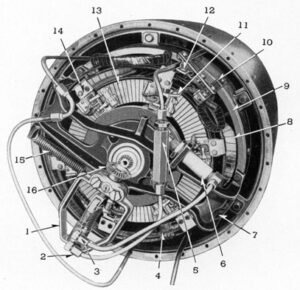 But NTS all but blocked progress so much it ended on the desk of Admiral Lockwood, who rushed into William H. “Spike” Blandy, Chief of BuOrd’s office. After vivid explanations, added to the general discontent with the mark 14, the matter was settled and the Mark 18 prioritized. By late 1943, as it was already delivered for months, issues reported in droves, the most damming being a dangerous ciscular pattern in some cases (likely claiming USS Tang). It should be said that the orginal G7e itself was already problematic. But most issues were ironed out by late 1944. Still, the Mark 18 made only 30% of the torpedoes fired by US subs in WW2.
But NTS all but blocked progress so much it ended on the desk of Admiral Lockwood, who rushed into William H. “Spike” Blandy, Chief of BuOrd’s office. After vivid explanations, added to the general discontent with the mark 14, the matter was settled and the Mark 18 prioritized. By late 1943, as it was already delivered for months, issues reported in droves, the most damming being a dangerous ciscular pattern in some cases (likely claiming USS Tang). It should be said that the orginal G7e itself was already problematic. But most issues were ironed out by late 1944. Still, the Mark 18 made only 30% of the torpedoes fired by US subs in WW2.
The main advantage of the Mark 18 was its lack of bubble wake or visible turbine exhaust. It was virtually invisible. But it was slow, dangerous to reload and complicated to maintain. The batteries were way too sensitive. In July 1944 a new model appeared, but it remained problematic until replacement in 1950.
⚙ specifications Mark 18 TORPEDO
Weight: 3,154 lb (1,431 kg)
Dimensions: 245 in (6.2 m x 21 in (530 mm)
Propulsion: Electric motor, Exide batteries
Range/speed setting: 29 knots (54 km/h) 4,000 yd (3,700 m).
Warhead Mod 0: 600 lb (272 kg), Mod2: 595 lb (270 kg), Mod 3: 575 lb (261 kg)
Guidance: Mark 12 Mod 3 gyro, straight pattern
Detonation: Mk 8 contact exploder or Mk 9 contact/influence exploder.
Most targets by 1944-45, when most Balao became operational, were now down to sampans, barges, “sea trucks”, or all manner of forcibly requisitioned vessels were impressed in supplying isolated garrison scaterred across the Pacific. Already the bloodline of tankers, frighters, and cargo-passenger ships of regular Japanese lines had been dried up, so Balao captains simply ran out of valuable targets and surfaced for deck gun attacks. Early Balaos, unlike earlu Gatos, swapped theor standard 3-in/50 Mark 17 for the heavier, but more potent 4-inch (102 mm)/50 caliber Mk. 9 gun.
War experience shown these were less desirable than the 5-inch (127 mm)/25 caliber Mk. 17 which shared the same mounts as on battleships and cruisers of the “wet” type to avoid corrosion issues given their materials, also using power-operated loading. Aiming features were removed. These conversions started already by late 1943, witj in some cases, two of these installed by late 1944. USS Spadefish (commissioned by March 1944) even innovated by having a purpose-built 5-inch (130 mm)/25 with a dedicated submarine mount…
4-inch/50-caliber gun Mk9
Standard intermediate light gun which design dated back 1898. The Mark 9 was installed as an alternative to the 5-in/25 in short supply. It had heavier rounds and higher muzzle velocity but was slower to fire and only had a marginally better range.
⚙ specifications 4-in/50 Mark 9 |
|
| Weight | 5,900 lb (2,700 kg) (with breech) |
| Barrel length | 204.5 in (5,190 mm)oa, barrel 200 in (5,080 mm) |
| Elevation/Traverse | -15/+20 degrees |
| Loading system | Manual, vertical sliding wedge type breech |
| Muzzle velocity | 2,900 ft/s (880 m/s) |
| Range | 15,920 yd (14,560 m) at 20° |
| Guidance | Optical |
| Crew | 6 |
| Round | Fixed 33 lb (15 kg), 62.4–64.75 lb (28.30–29.37 kg) complete round |
| Rate of Fire | 8 – 9 rounds per minute |
5-inch/25-caliber gun Mk17
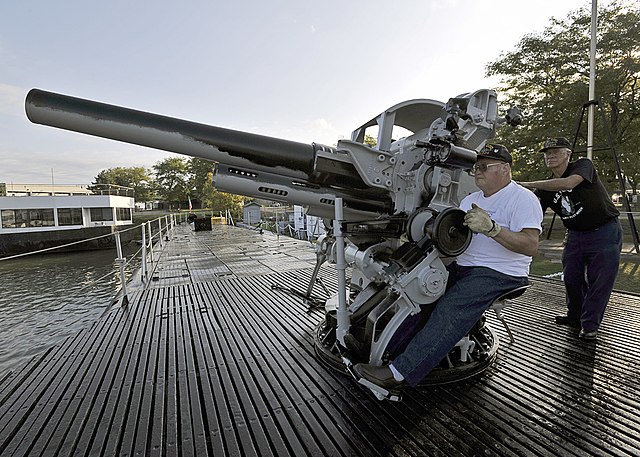
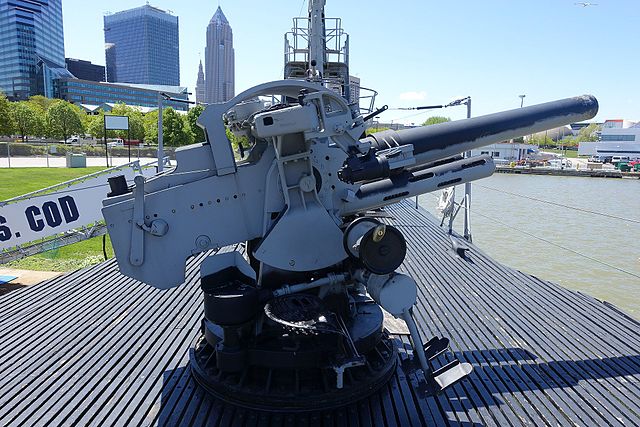
Installed when available from 1943, this ordnance started its career in the 1920s as a new 5″/25 AA gun before being declined in furth variants, Mark 17 being the last of these, developed for submarines. It weighted 2 metric tons, used the Mark 40 submarine gun mount for semi-fixed ammunition (case and projectile handled separately), but existing WW II photographs and drawings of ammunition storage show fixed ammunition. Range was just of 14,500 yards (13,300 m) the same or inferior to the 3-in/4-in/50 guns due to the short barrel, at 40 degrees elevation which was manual as well as training. From august 1944 some Gato class received even two of these (additional one forward) assisted by the Mark 6 “Baby Ford” fire control computer with a Mark 6 stable element. Not on the Tambor. They kept their single aft gun all along.
⚙ specifications 5-in/25 Mark 17 |
|
| Weight | 2 metric tons |
| Barrel length | 11 ft 10 in (3.6 m) oa, Barrel 10 ft 5 in (3,175 mm) |
| Elevation/Traverse | -15/+40 degrees |
| Loading system | Manual, vertical sliding wedge type breech |
| Muzzle velocity | 2,100 ft/s (640 m/s) average |
| Range | 14,500 yards (13,300 m) at 40° (effective) |
| Guidance | Optical |
| Crew | 6 |
| Round | Fixed, 127 × 626 mm R 54.5 lb (24.7 kg) |
| Rate of Fire | 5 rounds per minute |
AA Artillery
Additional anti-aircraft guns were installed from the start, notably one or two 20 mm Oerlikon mounts, and in alternative one or two 40 mm Bofors. For the 20 mm, twin mounts were also standard by 1944, but there was a large variety of armaments mixes enabled by the equally reinforced forward and aft gun decks, either side of the conning tower. Combinations such as these were possible:
-Fwd 4-in/50 gun, aft deck Bofors, single 20 mm on CT aft platform
-Fwd 4-in/50 gun, aft deck Bofors, 2x single 20 mm on CT fwd and aft platform
-Fwd 4-in/50 gun, aft deck Bofors, twin 20 mm on CT, single on aft platform
-Fwd 4-in/50 gun, aft deck Bofors, single 20 mm on CT, twin on aft platform
-Fwd 4-in/50 gun, aft deck Bofors, twin 20 mm on both CT and aft platform
-Fwd 4-in/50 gun, aft deck Bofors, aft Ct platform Bofors, fwd single/twin 20 mm
-Fwd 5-in/25 gun, aft deck 4-in/50, aft Ct platform Bofors, fwd single/twin 20 mm
-Fwd 5-in/25 gun, aft deck 4-in/50, aft and fwd Ct platforms single/twin 20 mm
etc…
This and the number of fairwater/CT modifications explains the “jungle” of configurations encountered late in the war.
Mines
Like the Tambor/Ga/Gato, the Balao class had mines that could be carried instead of torpedoes, of the 21-inches diameter compatible Mk 10 and Mk 12 types of World War II. Replacement was two mines for a torpedo, making for a maximal theoretical of 48 mines. Doctrine however pointed out retaining at least four torpedoes for self-defence making for 40 mines. Most publications also confirms this. But practice differed, with at least eight torpedoes kept, with the largest minefields ever reported from single Balao class subs being of 32 mines. Captains indeed retained a maximum of torpedoes as “insurance”. Post-war, Mk 49 mines were introduced, replacing the Mk 12, and the larger Mk 27 acoustic-homing ‘mine-torpedo’ carried with a replacement of one-to-one basis.
Mark 10 Mines Mod 1
In December 1941 the USN had in stock some 1,200 Mark 10 as Moored Hertz Horn for 21-inch torpedo tube and only 600 Mark 12.
Production was rapidly ramped up. The Mark 10 project was started in 1921, halted and resumed.
Base specs were:
Mod 1 contact fired: 1,760 lbs. (798 kg) total, charge 300 lbs. (136 kg).
Mod 2 was cancelled
Mod 3: Magnetic: Weighed 1,800 lbs. (816 kg) with a charge of 420 lbs. (190 kg) TNT.
Mod 11: Moored contact mine for USS Argonaut (SS-166) only.
Mark 12 Mines Mod 3
Submarine launched mine designed to be launched from a standard 21 inches or 53.3 cm torpedo tube. They were cylindrical, with an aluminum case. The model was derived from war prize German models in the 1920s, the S-type mines. The Mod 1 was an (airborne) parachute mine, M3 was the submarine type. Some were delivered to Manila just before the Japanese invasion and were dumped into deep water to prevent capture. In total, when carrying just a few spare torpedoes in minelaying missions, the S-class could carry a total of 32 Mark 12 mines.
⚙ specifications Mark 12 mod 3 Mines
Dimensions: 94.25 inches long, 20.8 inches wide. (2,394 m x 0.53 m).
Weight: 1,445 lbs. (655 kg), 1,100 lbs. (499 kg) TNT charge or 1,595 lbs. (723 kg) with a 1,250 lbs. (567 kg) Torpex charge.
Pissibly replaced in 1944 by the Mark 24 submarine launched ground mine. src
Sensors
Sonars
QCC sonar:
The QC/JK gear was located in the Conning Tower, companion units with the QC gear as active/passive sonar and JK gear (passive only). Raides and lowered by a hydraulic system, training by electric motor controlled by handle in the operating station. QCC: No data.
JK sonar:
The JK/QC combination projector is mounted portside. The JK face is just like QB. The QC face contains small nickel tubes, which change size when a sound wave strikes this face. (The NM projector, mounted on the hull centerline in the forward trim tank, is used only for echo sounding.)
Se the full reference here
Radars
SD Radar
The SD radar was a small early navigation and early warning radar developed by the US Naval Research Lab. between 1940 and 1941. It was installed on submarines mostly to warn them of an incoming aircraft beyond visual range. It has an omnidirectional antenna, however and was rather limited in range, and thus could be used also as proximity radar. It could detect bombers at 1000 ft alt. from 12-20 miles, small one at 8-15 miles and no low-flying objects. Plus being active it could also be detected by other submarines, so use was restricted.
Specs:
Introduced in 1941, 400+ made. Powered by 100 kw (SD-5 130 kw).
FRQ 114 MHz, PRF 60 Hz, bmwt 40° horizontal, Pdt 8.5 µs, 4 RPM
RA 20 mi (32 km), accuracy 450 m (1,480 ft).
SJ radar
S band (10-cm) radar developed from 1941 and introduced in June 1942 on US and allied subs. First prototype deployed in December 1941. Stanbdard on US subs from early 1943. Variant of the SG surface search radar. Alaso capabke of detecting low-flying aircraft and used as a communications device with telegraph key, to send signals on a point-to-point basis, used generally in wolf packs, in directional short range mode.
Specs:
Frequency: S-band (10cm wavelength)
PRF: 1350-1650
Beamwidth: 7.5° × 13°
Pulsewidth: 1 μs
Range 30 miles for the SJ-1.
Power 50 KW for the SJa.
JH-1 Hydrophone
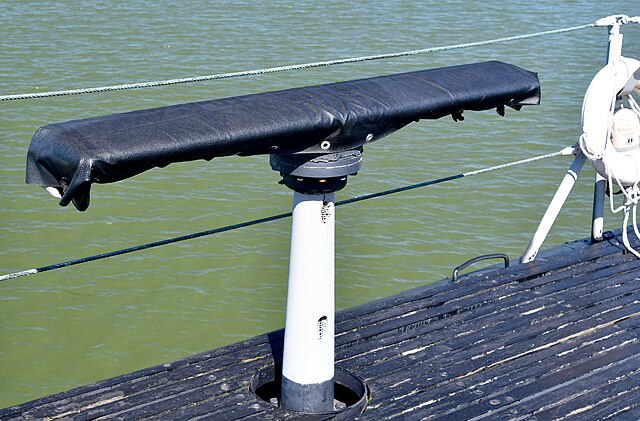

No data so far.
Appearance




Early Balao class boats in 1943 sported the same dark gray-black livery standard of 1942 Gato class MS 9, hull number painted out, with a 2-digit number on the CT but most have the same all medium grey for the upper parts, with a darkened medium blue rear section, all black around the pressure hull at waterline level but following the filler scoop line. USS Balao alone was noted having in 1944-45 MS 32/3SS-B, with some boats still sporting MS9 in 1944 and the remainder all in MS 32/3SS-B by the end of the war.
Measure 9
Named officially “Black System for Submarines”, decided in January 1941. Vertical Surfaces above the waterline black in formula 82 black for all parts visible from the air, including the numbers, capstan and running light boards and bridge rails, radio insulators, no boot topping.
Underbody in the current issues of bottom antifouling paints.
Horizontal Surfaces (except wooden decks) in Dark Gray 5-D. On sloping surfaces, Dark Gray 5-D.
It was precised that small gear, wires, rigging, areas permanently in shadow were not painted. Bright or shiny object needed to be painted, covered, or removed.
Glass windows covered or removed as well as airport lenses.
Measure 32, design 3SS-B
Measure 32 precognised a type of camouflage for surface shiops made “austere” for Gat-Balao class subs, with the vertical Surfaces using a pattern of Light Gray 5-L, Ocean Gray 5-O (rer upper deck end) and Black for the remainder of the hull, Horizontal Surfaces in Deck Blue, 20-B and Ocean Gray 5-O. Same instruction as above for anything shiny.
⚙ Balao class specifications (1944) |
|
| Displacement | 1,526 tons (1,550 t) surfaced, 2,391–2,424 tons (2,429–2463 t) submerged |
| Dimensions | 311 ft 6 in x 27 ft 3 in–27 ft 4 in x 16 ft 10 in (94.9 x 8.3 x 5.13 m) |
| Dimensions (later batches) | 311 ft 10 in x 27 ft 3 in–27 ft 4 in x 16 ft 10 in (95 x 8.3 x 5.13 m) |
| Propulsion: Diesels | 4 × diesels driving electrical generators, Fairbanks-Morse or General Motors |
| Propulsion: Electric Engines | 4 × high-speed EM with reduction gears/2 × low-speed EM (Elliott Company or GM) |
| Propulsion: Batteries | 2 × 126-cell Sargo batteries |
| Total Output: | 5,400 shp (4,000 kW) surfaced, 2,740 shp (2,040 kW) submerged |
| Speed | 20.25 knots (38 km/h) surfaced, 8.75 knots (16 km/h) submerged |
| Range | 11,000 nautical miles (13,000 mi) surfaced at 10 knots |
| Autonomy | 48 hours at 2 knots (3.7 km/h) submerged, 75 days on patrol |
| Armament | 10 × 21-in TTs (6 fwd/4 aft, 24), 5-in/25, Bofors 40 mm, Oerlikon 20 mm |
| Sensors | QCC/JK Sonar, SJ radar, see notes |
| Test Depth | 400 ft (120 m) |
| Crew | 10 officers, 70-1 enlisted men |
Construction
As the the most numerous US submarine class in history, 120 boats were ultimately commissioned from February 1943 until September 1948, after construction was stopped for many of them in September 1945, pending a decision. In all, 12 saw nothing of WW2 with a construction resumed in 1946-47 and commissioned postwar. Nine were lost, plus five postwar (One in Turkish service in 1953, one in Argentine service in the Falklands 1982, one in Peruvian service in 1988). USS Lancetfish was flooded and sank while fitting out at Boston Naval Shipyard, on 15 March 1945, never repaired, listed in reserve postwar until struck in 1958. The fact most Balao class were completed for a relatively short service, at best mid-1943 to late 1945, meant they were in generally good condtions, and their deeper diving hull ade them more valuable than the Gatos, so they saw long service, either as “austere” fleet snorkels (just a snorkel added) until the 1970s, or as GUPPY conversions, generally I, Ib and I-IIa. ROKS Hai Pao (ex-Tusk) remained active in Taiwan’s Republic until very recently, used as Training boat.
SS-361 through SS-364 were initially ordered, assigned hull numbers in middle range numbers notably SS-285 to SS-416 & 425–426 and thus, listed as Balaos in some publications but were completed as Gatos in Manitowoc due to delays from EB to deliver the Balao-class drawings to this yard. Manitowoc was dependent on them for designs and drawings and had no choice but to continue producing Gatos as a stopgap to not interrupt construction. USS Trumpetfish (SS-425) and USS Tusk (SS-426) are listed as Tench class boats in some references, having hull numbers in the latter range.
Cancellations started between 29 July 1944 and 12 August 1945. There were three Tench-class boats exceptions that were cancelled 7 January 1946. Most sources agree on 120 bots for this class, but it’s not universal. USS Trumpetfish (SS-425) and Tusk (SS-426) were generally assumed completed as Balaos. Among cancelled Balao-class were SS-353-360 and 379–380 but the Register of Ships considering every submarine not specifically ordered as a Tench to be a Balao. SS-551-562 were assumed to be successors of the Tench. Most sources agrees on 62 cancelled Balao class, 51 cancelled Tench class, 12 cancelled “future class”. Two cancelled Balao-class, USS Turbot (SS-427) and Ulua (SS-428), were launched incomplete and became experimental hulks at Annapolis and Norfolk. Cancelled hull numbers were SS-353–360 (Balao), 379–380 (Balao), 427–434 (Balao), 436–437 (Tench), 438–474 (Balao), 491–521 (Tench), 526–529 (Tench), 530–536 (Balao), 537–550 (Tench), and 551–562 (future).
Ongoing Modifications
Between the Balao class that were modified in earl batches (Mod 3) and mid-batches (3a) or late batches (Mod 4, 4a) plus the ones retofitted to later mods in refits, here are the details of these modifications.
Mod 3:
This was the most recoignisable modification, by the full removal of the fairing around the pilothouse and former surface steering station. In short, not pilothouse at all (considered as redundant as the captain could communicate easily with the Command center below and submarine drivers), and instead a platform was created to support a Mark 5 20 mm AA gun mount, making two, one forward, one aft. All remaining bulwark was cut away. There was a small walkway platform around the top of the support around the periscope “lattice” for lookouts. Some boats however had had a portion of bulwrk retained and half-moon cutouts to fill the bridge’s structuren acting also as windows. There were also extra ammunition storage lockers instealled forward. USS Gato was modified that way in mid-1943. Many which still had their original 3-in/50 swa it swapped for a 4-in.40 mark 9, placed forward. Some also had their Mark 5 AA mount replaced b Mark 10 mounts.
Mod 3A:
Detailed modifications from the above, notably the watertight access door for the gun crew at the after end of the CT was a liability in combat and could be unseated in depth charge attack and cause rapid flooding. It was eliminated in the spring of 1943 from all boats and ported in construction. There was a new outward dished convex aft end for the CT. This also provisonally increased room in the conning tower but access to the deck gun proved more tricky. Also the The SD radar mast was moved aft, out of the CT, with a new mast installed on the cigarette deck, also benefiting from a better azimuth, with its mount still attached to the CT. This was mostly done from late 1944 onwards.
Also in 1944, some boats obtained a swap to the 5-in/25 deck gun. It was located forward. Some had their forward 20 mm Oerlikon mount reeplaced by a Mark 1/2 mount for a 40 mm Bofors, despite the lack of space on this forward platform. A 20 mm was kept aft, unshielded of course due to drag when diving. Further sub-mods performed in 1945 consisted in fitting the new SV radar with its larger mesh-wire antenna, additional ammo lockers (notably the 40 mm rounds were much larger), new lookout posts, spindle mounts for Browning M2 AA HMGs. There was also a swap on some boats, with the 5-in/25 main gun relocated aft, to make room for an extra 20 mm AA mount Mark 10 instead, making for one Bofors, two Oerlikons, up to four 0.5 inch HMGs, quite an impressive AA defence.
Mod 4:

Bridge lowered to even make the silhouette less apparent. Plating was removed, this caused to expose the I-beams of the persicope shears. This was done on some boats by early to mid-1944 onwards. On some boats, the lookput platform was made larger using the now apparent transverse I-beams as supports, Modifications done to the forward section of the lowered bridge with a new access door and ammunition scuttle, new lower ammunition storage lockers, 4-in/50 froward, 20 mm Mark 10 mount on the forward PF and same aft plus a TBT stand and rear ammunition storage locker.
Mod 4A:
Both radar masts (SJ-1 and SV) out of the shears, modified lookout platforms, wind venturi forward of the bridge (with several variants), and the hull modified with upper rows of small circular limber holes (on USS Cero, Dace, Albacore, Scamp first) to accelerate the outer hull filling. Some obtained an APR stub antenna for enemy radar detection forward of the shears. On some also an RDF loop antenna was also installed. On some boats, gun shields were installed on the Mark 10 gun mounts for and aft. There were no “mod 5” but the Tench and Balao received all these mods while in construction. There were also countless variations of the modifications above between ships.
In addition, some boats lost one of their anchors and the hawse hole plated over, some had their their bow planes modified to decrease diving times and modified stowage. The original mine cable cutters installed were retractable and stowed either side of the bow on the upper edge of the superstructure forward of the bow planes, and above the torpedo tube outer doors. They could be mounted if needed, but this was never done. This concerned only early batches, 20 boats total. This equipment was later judged “frivolous” and eliminated altogether.
Read more here (true treasure of info on these changes)
The Balao class in action
The Balaos arrived on the scene by mid-1943. Issues with the Mark 14 torpedo were mostly solved at that point, with field modifications done on the torpedoes emanating from offficial instruction, new parts being delivered for this, or newly delivered Mark 14s. So this allowed this mass of Balaos to be ver effective from the very start and gut the Japanese merchant fleet while crippling the Imperial Japanese Navy. USS Archerfish remains today for example the largest warship “kill” ever by a submarine, armoured carrier IJN Shinano (59,000 tons). USS Tang became the highest-scoring of the class with 33 ships totaling 116,454 tons and second high scorer of all Gato/Balao/Tench collectively and of all US submarines to date.
Nine Balaos were lost plus two in postwar accidents in US service only. In foreign service three were inclusing one in action, ARA Santa Fe (S-21) in the 1982 Falklands War, and by ATGMs launched by an helicopter while berthed.
As said above, USS Lancetfish was commissioned incomplete while she was lost, sinking pierside at Boston Navy Yard on 15 March 1945. The issue came from a yard worker which mistakenly opened the inner door of an aft torpedo tube, which unfortnunately had the outer door open, not seeing any caution symbol as the system was apparently deactivated or not operational yet. No personnel were lost. Lancetfish was raised, decommissioned, never completed and only stayed 42 days in commission, remaining the record for any USN submarine. Postwar she ended in the Reserve Fleet until stricken in 1958.
See the details of the losses in the next career part details. But in short, an overview of these causes is helpful to try to poprtray a pattern of the greatest threat to US subs at the time:
USS Cisco (SS-290) was sunk on 28 September 1943 and after a combination of air attack and the gunboat Karatsu, ex-USS Luzon while surfaced.
USS Capelin (SS-289) was sunk on December 1943, unknown, mine or possible attack by the minesweeper Wakataka.
USS Escolar (SS-294) was sunk between 17 October and 13 November 1944, probably to enemy mine.
USS Shark (SS-314) was sunk on 24 October 1944 by depht-charging from IJN Harukaze
USS Tang (SS-306) was sunk on 25 October 1944 by a circular run of a Mark 18 torpedo (her very last).
USS Barbel (SS-316) was sunk on 4 February 1945 while surfaced by an Air attack
USS Kete (SS-369) was sunk in March 1945, unknown cause either mine or enemy DC attack.
USS Lagarto (SS-371) was sunk on 3 May 1945, depth charged by IJN Hatsutaka
USS Bullhead (SS-332) was sunk on 6 August 1945 by air attack, Mitsubishi Ki-51*
* the Type 99 Assault Plane “Sonia” was a light 1939 army dive bomber.
These examples showed that when surfaced, surviving chances were slim. It also showed that the IJN and IJA escorted their ships almost always by planes, even though they were not tailored for ASW patrols. This was a very efficient way of spotting a submarine either surfaced or underwater in the clear and shallow waters around attolls and islands. After the usual destroyer ASW attacks, mines (it is a possible cause, not certain) proved also deadly. In 1943 when it was well understood that US submarines were reamong their own home waters, it was decided to plant mines off all important bases and ports, passages and give precise instructions to convoys to pass through. This proved effective but we will never known axactly how much US subs were hit by them.
Postwar:
USS Cochino (SS-345) was sunk on 26 August 1949, so in an Accidental fire.
TCG Dumlupinar (D-6) (ex USS Blower) was lost in collision on 4 April 1953 with MV Naboland.
USS Stickleback (SS-415) was lost in collision as well on 28 May 1958 with USS Silverstein (DE-534).
ARA Santa Fe (S-21) (ex USS Catfish) was lost in action on 25 April 1982 by helicopter attack, then captured in Operation Paraquet, South Georgia.
BAP Pacocha (SS-48) (ex USS Atule) sank in collision also on 26 August 1988 with the large off shore Japanese fishing ship Kiowa Maru.
Doctrine
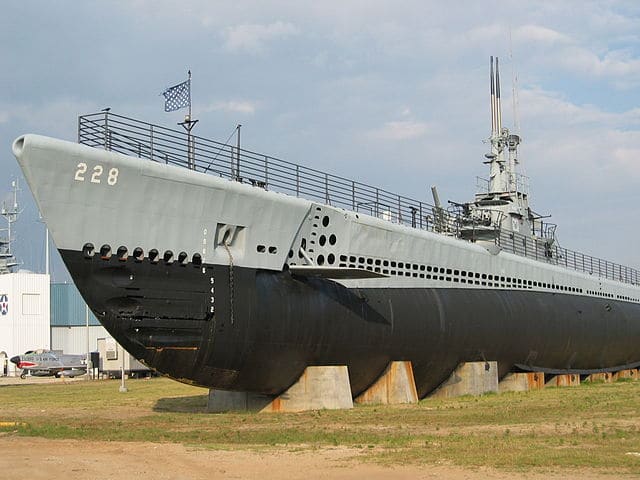
USS Drum, SS-228 preserved in Mobile, Alabama
Fleet submarines was completely changed after the loss of the battle fleet in December 1941, notably under the impulsion of commander Lockwood, sent into “search and destroy” patrols either in home waters or on all possible routes to important Japanese bases and outposts across the Pacific. Lockwood notably argued they were perfectly suited for a war of attrition on Japanese trade, with accessory warships, if met. Japanese merchant shipping was indeed in 1942 often loosely escorted, with regular destroyers, no aicraft cover. There were never enough destroyers to provide escort, nor dedicated short range sub-hunters, leading the IJN to order two classes of dedicated escort destroyers (Matsu and Tachibana, plus more than 200+ numbered escort ships, which were mass produced in 1944-45. Skippers were free to roam a concerted, central operation designated area, but in local “free hunt” withing that frame. It was still directed and managed from higher-ups. They had to surface for regular points when in a safe area, to receive new instructions of be vectored in to an interception point. Information sharing soon helped identifying the major Japanese communication links and strategic ports, and helped defining these hunting areas.
It’s no mystery that, while studying German tactics in the Atlantic, the same were adopted and adapted to the Pacific for Gatos and Balaos.
The first patrols were based out of Australia (for New Guina-Solomons Operations), or Hawaii and Midway for Home waters and routes towards Truk, the Marshalls and other islands chains. Some also operated in the Java Sea, but most met their greatest kills in the Sea of Japan. By mid-1943 also skipper were long freed of the initial London Naval Treaty dictating “prize rules” law. IJN transports being armed, this became fair game. On the long run, as targets dried out, Balaos were down to sinking sampans, barges, trawlers, small steamers (“sea trucks”), schooner, when surfaced, and not noting if armed or not.
Wolfpack Tactics
Although in late 1942, the usual modus operandi was by individual patrols, wolfpack tactics started to be adopted systematically by the Central Pacific command under Rear Admiral Charles Lockwood based in Pearl Harbor (SubPac) from 1943 onwards. Whe Balaos skippers arrive don the scene in mid-1943, wolfpacks were a common tactic, while individual skippers retained considerable autonomy within. These “coordinated attack groups” were generally of at least two, and most often three boats, patrolling in “loose” company (at radio distance) and leaving port ordagnized under a single command, generally the senior submarine commander of the three. “Swede” Momsen was one of the most promiinent advocated for closely integrated wolfpacks and devised early US wolfpack tactics with USS Cero, Shad and Grayback (Gatos) operating from Midway from 1 October 1943. The idea ws to spread out in recce, report positions of convoys for the others to come and be mutually supportive during the attacks. Night attacks were favored due to the subs 21 knots surfaced, more than German submarines. These wolfpacks earned names such as “Ben’s Busters” or “Blakely’s Behemoths”. More on this topic.
Balao class Feats
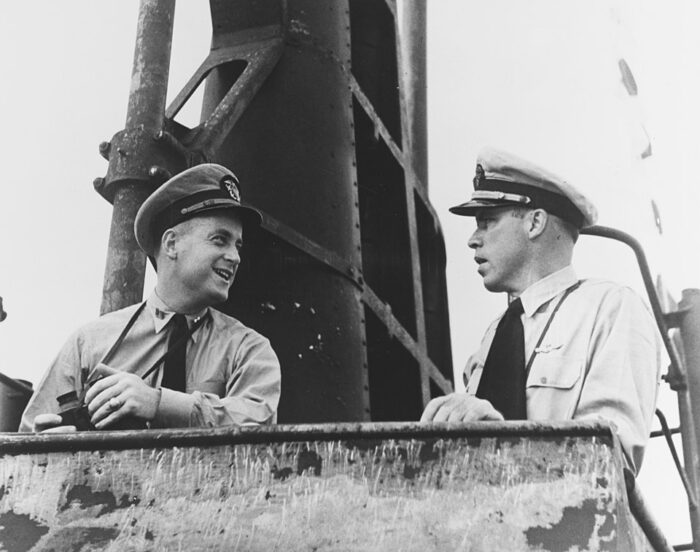
Richard O’Kane and Dudley Morton on the bridge of USS Wahoo in February 1943.
-USS Tang second best US submarine for ships sunk with 33, first for tonnage with 116,454. Her third patrol became legendary, remaining for ever the most successful of any U.S. submarine, with 10 ships and 39,100 tons. But as she was immensely successful, her end was very ironic as she was Sunk in the Taiwan Strait by a circular run of her own torpedo. Indeed her skipper Richard O’Kane and eight others escaped after she went down, with the only known successful use of the Momsen Lung. Tang’s survivors became POWs until the rest of the war. Richard O’Kane became a Medal of Honor recipient, especially for the actions of the convoy battles on 24 and 25 October 1944.
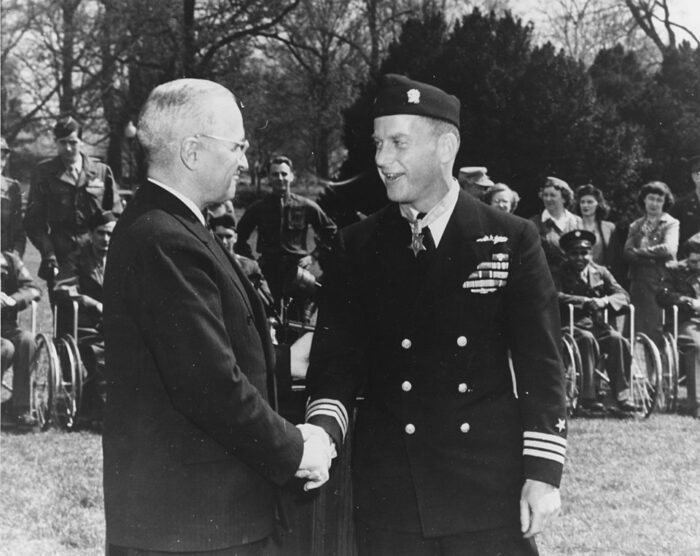
“Dick” O’Kane (died February 16, 1994 in Petaluma, Cal.) was awarded the Medal of Honor, three Navy Crosses, three Silver Stars, the Legion of Merit with “V”, Purple Heart and several other decorations throughout his career. He remains one of the best submarine commanders in US history. Hos cribbage board with a particularly lucky hand, became later became a treasured item, still passed on from one crew to another on modern USN SSNs.
-USS Archerfish held the record for the largest warship even sank by a submarine, the aircraft carrier Shinano, earning Commander Enright the Navy Cross.
-USS Batfish is preserved as a museum ship in Oklahoma, ans in her career she had a record for sinking three Japanese submarines, RO-55, RO-112, and RO-113 ovr three days and also sank the destroyer Samidare.
-USS Redfish claimed two IJN aicraft carriers: On December 9th, she was part of the wolfpack badly damaging Junyō beyond repair, and 10 days later she torpedoed and sank alone the aircraft carrier Unryū. After the war she was transformed to play the legendary Jule Verne’s Nautilus in Walt Disney’s “20,000 Leagues Under the Sea” and USS Nerka in the 1958 “Run Silent, Run Deep”, and in the serie “Silent Service”.
-USS Sealion sank the Japanese battleship Kongō and destroyer Urakaze.
-USS Blackfin sank Shigure, the “fortune ship”, totally unscaved from battles of Vella Gulf and Surigao Strait and all the Solomon Islands campaign, avenging USS Growler. Since her actions were relayed by Japanese propaganda, her loss was crippling for Japanese morale.
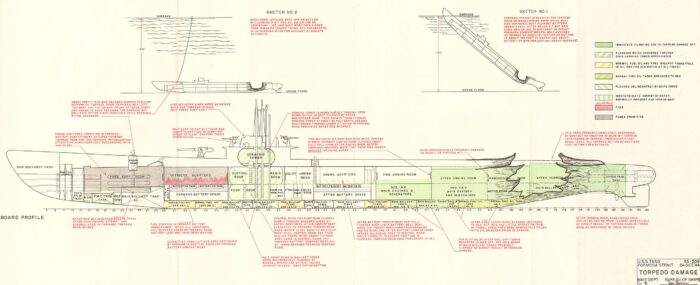
Damage assessment of USS Tang after a torpedo circular run.
Balao class Top Scorers
USS Tang: 116,454t sunk in WW2, 1st.
USS Spadefish: Balao-class 88,091 t, 6th
USS Seahorse: 12th
USS Sealion: 17th
USS Archerfish: 59,800t, 20th.
The first point brought us inevitably to this list, which is still contested by modern historians, many considering JANAC record to be “shaky”.
Overall a less impressive tally compared to the Gatos, but just. Let’s remamember the Balaos arrived for most, late in the war.
The Balao class Postwar: Fleet Snorkel
Cold War Classifications Index
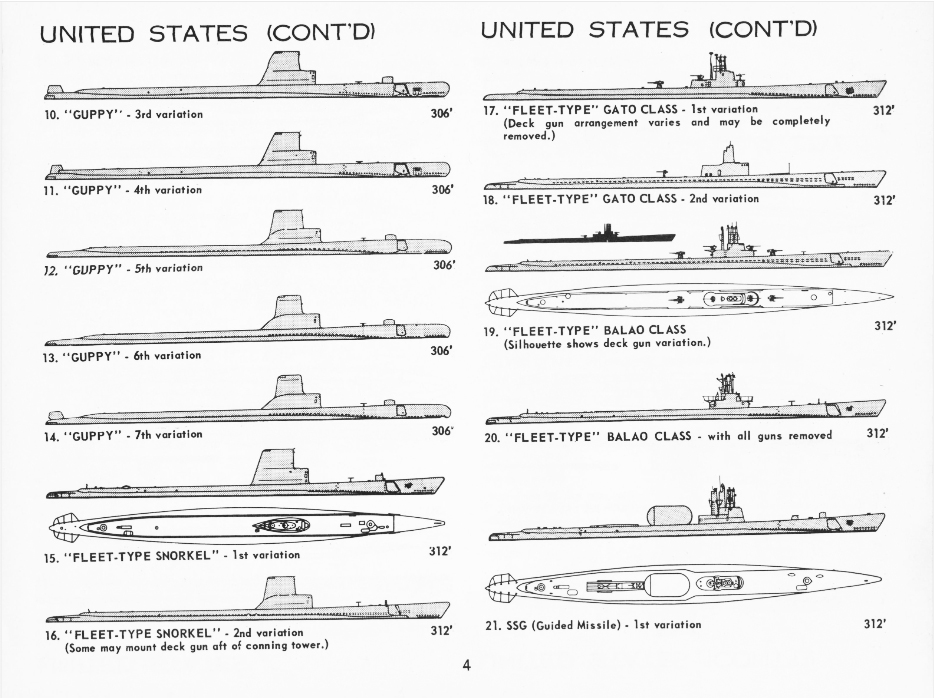
Postwar ONI recce book on Gato/Tench/Balao variants
AGSS: Auxiliary submarine (various roles including sonar testing and some pierside trainers)
FS: “fleet snorkel” conversion, including a snorkel and streamlined sail
G IA/G II/III/IIa/IIIa: GUPPY conversions, with snorkel, streamlined sail, improved batteries, upgraded sonar
IXSS: Unclassified utility
PT: pierside trainer for naval reservists, no propellers.
SSA/ASSA: cargo submarine
SSG: guided missile submarine
SSP/ASSP/APSS/LPSS: Amphibious transport submarine
SSR: radar picket submarine
GUPPY Conversions
Unlike the older Gatos, Balao and Tench boats were preferred from GUPPY conversions. Here are following these different conversions by types and dates. At the end of World War II, the 120 remaining Balao-class, many of which were completed quite late (last completed in 1951) were already considered obsolete compared to the new Type XXI, which was tested and showed how can classic diesel-electric subs would be modenrized in a radical way for increased underwater performaces. Balao and Tench ships had twice the diving depth of the Gatos and the later were unable of front-line missions. The Greater Underwater Propulsion Power Program (GUPPY) modernization did not concerned the Gatos, apart USS Barb and Dace, in an austere GUPPY IB modernization, project SCB 47A. Both were sold to the Italian Navy under MDAP. Gatos were reactivated to replaced the now scrapped S-class for training with the very last decommissioned on 13 September 1969.
SSG Conversions
(To come in a future upgrade)
Cargo submarine conversions
SSA:
ASSA:
(To come in a future upgrade)
Naval Reserve trainer (PT)
In case of war, the USN like to keep a large reservists force, and assigned many ex-Gatos for this role, going from coastal and inland ports (even in the Great Lakes) as training platform in weekend drills. 23 Balao-class performed as such until 1971 for some. The ones permanently berthed had their propellers and pumps removed as pierside trainers. Their status was “in commission in reserve”.
Migraine Conversions
Kamikazes in 1944-45 led the navy top brass to ask for a greater radar cover and if many destroyers were used as such, attrition rate was enormous, so submarines were preferred in this role, with the ability to quickly submerge in case of air attack. Several Gato class were converted for a long-range radar umbrella around the fleet. Some of the Balao class were also converted and they received powerful radar suites. The prototypes had been USS Grouper and Finback. These were rudimentary conversions but ultimately never used in this role. After them, four Balao and Tench-class were converted in 1945 (Projects Migraine I and II). None was ready when WW2 ended. Instead they ensured long range offshore at sea radar coverage in the immediate late 1640s and 1950s. Read More
Legacy: Surviving Balao class Boats
Six Balao-class submarines are now open to public as museum ships, with a maintainance to standards on ticket sales, with a yearly inspection and a “report card”. Batfish and Pampanito also enabled a group of volunteers to sleep overnight in the crew’s quarters. These preserve boats are the following:
USS Batfish (SS-310), War Memorial Park in Muskogee, Oklahoma ☍
USS Becuna (SS-319), at Independence Seaport Museum in Philadelphia ☍
USS Bowfin (SS-287), at USS Bowfin Submarine Museum & Park in Honolulu ☍
USS Lionfish (SS-298), at Battleship Cove in Fall River, Massachusetts ☍
USS Pampanito (SS-383)n at San Francisco Maritime National Historical Park in San Francisco ☍
USS Razorback (SS-394) at Arkansas Inland Maritime Museum in North Little Rock, Arkansas ☍
No longer there:
USS Clamagore (SS-343) was a museum boat at Patriots Point in Charleston (closed in 2021, scrapped 2023).
USS Ling (SS-297) is aground in the Hackensack River, former New Jersey Naval Museum, left to rot. Her Sail was preserved however.
USS Baya (SS-318) displmays its persicope at the Vallejo Naval and Historical Museum.
USS Pintado (SS-387)’s conning tower is at National Museum of the Pacific War in Fredericksburg, Texas
USS Parche (SS-384)’s CT also is at USS Bowfin Submarine Museum & Park in Honolulu.
USS Balao (SS-285)’s CT is at Washington Navy Yard in Washington D.C.
Exports: The Balao class under other flags
(To come)
The Balao class in Action
With 120 submarines, detailing their career would make that article overbloated… So instead i chooses to single out the best performing in class, and lead boat of course. In the future there would be updates though.
 USS Balao SS-285 (1942)
USS Balao SS-285 (1942)
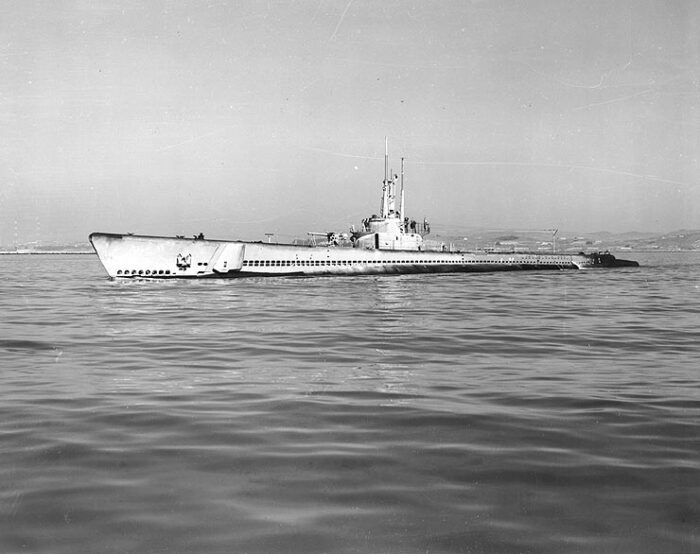
USS Balao was laid down at Portsmouth Naval Shipyard, Kittery, Maine (State yard) on 26 Jun 1942, launched on 27 Oct 1942 and completed on 4 Feb 1943 under Lieutenant Commander Theodore C. Aylward. After 6 weeks training off New London, she joined the 7th fleet at Brisbane, arrive on 10 July, attached to sub tender USS Fulton. 1st patrol 25 July – September 1943: 7 August took station in the scouting line between Truk and Bismarck Archipelago. Five enemy contacts, no attack. 26 August, shifted to Palau–Rabaul. Back to Brisbane 13 September. 2nd patrol, 4 October – 4 November 1943 with Silversides for Tulagi. Bismarck Archipelago, Palau-Rabaul. Convoy spotted 17 October, six missed. Coordinated attack on a 7-ship convoy 23 October, 10 torpedoes, 6 hits (all damaged only). Refuelled at Tulagi, load torpedoes. 28 October, south of Truk. 4 November, 2-ship convoy, six missed. Truk-New Hanover, uneventful. Back to Milne Bay, New Guinea.
3rd patrol: 6 December 1943 – 7 January 1944: 13 December communication and identification tests with search planes. No surface contacts for 2 weeks. 27 December spotted two Mogami-class cruisers, two Asashio-class destroyers zigzagging at 20 knots, four launched, overran. 1st Jan 44: Large steamer and two escorts, bad weather, fired 6, damaged the freighter. 7 January ordered back to Brisbane. 4th patrol, 6 February – 15 March 1944: 2 week refit, training, then sailed via Tulagi north of New Guinea 13 February, convoy spotted 23 February, 2 freighters, 1 small escort, fired 6, 3 hits. 1st kill: 5,857-ton Nikki Maru. 26 February spotted a convoy but chased off. Same 28th, 6 launched and swapped to stern tubes. Claimed 2,723-ton Shoho Maru and 6,803-ton Akiuro Maru. 3 March, Balao fired 4 torpedoes at a small freighter and escort, missed. Then convoy of 4 small ships, pulled away, no attack. 4 March spotted ships in a rain squall, fired 4 stern tubes (duds/passed underneath). No torpeodes left she sailed back to Langemak Bay, headed for Pearl Harbor (refit), 19 March 1944.
5th patrol, 25 April – 12 June 1944. Via Midway to refuel to Palau Islands. Small convoy on 14 May, repelled by escorts. Yap–Palau route, no attack, surface search radar deficient.
1 June, radar contact 4-ship convoy, tracked, attacked after midnight 2 June, 6 torpedoes, 2 hits but 2nd attempt thwarted. Fuel shortage forced her to Majuro, refit alongside sub tender USS Sperry.
6th patrol, 5 July – 12 August 1944. Majuro to Palau, few contacts. 26 July, bombardment of Angaur Island, destroyed a lighthouse and loading docks. Rescued a pilot from USS Bunker Hill. Lifeguard duties off Peleliu, 2 more 27 July. 29 July, joined USS Drum in a coordinated attack on two sampans with gunfire. 12 August, refit to USS Conyngham, sailed to Tanapag Harbor (Saipan), ordered back home, Mare Island Navy Yard 20 August for major overhaul, back to Pearl on 15 November.
7th patrol, 17 December 1944 – 19 January 1945: With USS Spot and Icefish, Tanapag Harbor, sub tender USS Fulton. Until 2 January 1945 few contacts, fishing craft and mines. Gunned down a masted schooner. 8 January, fired 6, 3 scored on a “tanker”, then 7 more, 3 more hits, 3 more, at least 2 hits close, sank 5,244-ton freighter Daigo Maru. No more spottings, ended in Apra Harbor, Guam, sub tender USS Apollo.
8th patrol, 27 February – 8 April 1945: Departed with Tench, Guardfish, and Sea Devil, East China/Yellow Seas. 9 March, small tanker, 2 escorts, fired 4, missed. No attacks afterwards. 18 March sank a 188-ton trawler with gunfire, later spotted a convoy of 4 transports, 4 escorts. Fired 10 (10,413-ton Hakozaki Maru, Tatsuhara Maru damaged). Later she sank a and damaged three small trawlers. 21 March, tracked a convoy of 2 ships, 4 escorts. At 1,400 yd (1,300 m) fired 4, no kill. 26 March, spotted and sank 880-ton Shinto Maru No. 1 with gunfire. 2 April while escaping an aicraft attack she dove too quickly and water poured in her conning tower, lost her radar and other electrical gear. Ended in Guam for refit.
9th patrol, 3 May – June 1945: Yellow Sea with Dragonet, Shad, Spikefish. 19 May, small freighter, 3 missed but sank a 30-ton junk. 23 May, issues with diving planes, sailed to Pearl Harbor for repairs, picked en route a sailor from Torsk (appendicitis) and injured Sand Lance crewman, but was attacked by torpedoes, dodged them. Likely UJN sub.
10th patrol, 7 July – 15 August 1945. Nanpō Islands area, east of Honshū in lifeguard services. Sank a picket boat, damage another with gunfire, 14 August. Went back home with USS Peto to transfer rescued aviators, and to Pearl Harbor 25 August. She was decommissioned on 20 Aug 1946, became Auxiliary Transport (AGSS) on 1st Apr 1960, struck 1 Aug 1963, sunk as target 4 Sep 1963, CT preserved as memorial USN Museum in Washington Ny DC.
 USS Billfish SS-286 (1942)
USS Billfish SS-286 (1942)
USS Billfish SS-286 laid down at Portsmouth Naval Shipyard, Kittery, Maine on 23 Jul 1942, launched on 12 Nov 1942 and commissioned on 20 Apr 1943. She was decommissioned on 1 Nov 1946, recommissioned as Pierside Trainer 1960-1968, Auxiliary Transport (AGSS) 1 Dec 1962 and stricken on 1 Apr 1968, sold for scrap on 17 March 1971.
 USS Bowfin SS-287 (1942)
USS Bowfin SS-287 (1942)
USS Bowfin was laid down at Portsmouth Naval Shipyard, Kittery, Maine on 23 July 1942, launched on 7 December 1942 and commissioned on 1 May 1943. She was decommissioned on 12 Feb 1947, Pierside Trainer 1960-1971, Auxiliary Transport (AGSS) 1 Dec 1962, IXSS 30 Jun 1971 stricken on 1 Dec. 1971, memorial at Pearl Harbor.
 USS Cabrilla SS-288 (1942)
USS Cabrilla SS-288 (1942)
USS Cabrilla was laid down on 18 Aug 1942 at Portsmouth Naval Shipyard on 24 Dec. 1942, commissioned on 24 May 1943. She was decommissioned on 7 Aug. 1946, Pierside Trainer 1960-1968, Auxiliary Transport (AGSS) 1 Dec 1962, stricken 30 Jun 1968, memorial at Galveston, Texas 1968-1971, and sold for scrap 18 April 1972.
 USS Capelin SS-289 (1942)
USS Capelin SS-289 (1942)
USS Capelin was laid down on 14 Sep 1942 at 20 Jan 1943 Portsmouth Naval Shipyard, launched on 4 June 1943. She was lost to unknown cause, around 2 Dec 1943.
 USS Cisco SS-290 (1942)
USS Cisco SS-290 (1942)
Cisco SS-290 was laid down on on 29 Oct 1942 at Portsmouth Naval Shipyard, launched on 24 Dec 1942 and commissioned on 10 May 1943. She was lost to Japanese air and surface attack, 28 Sep 1943.
 USS Crevalle SS-291 (1943)
USS Crevalle SS-291 (1943)
USS Crevalle was laid down on 14 Nov 1942 at Portsmouth Naval Shipyard, launched on 22 Feb 1943, and commissioned on 24 Jun 1943. She was decommissioned on 29 Jul 1946. She became Auxiliary Transport (AGSS) on 1 Apr 1960, Pierside Trainer 1962-1968; struck 15 Apr 1968, sold for scrap 17 Mar 1971.
 USS Devilfish SS-292 (1943)
USS Devilfish SS-292 (1943)
Devilfish was laid down at Cramp Shipbuilding Company, Philadelphia, Pennsylvania on 31 Mar 1942, launched on 30 May 1943 and commissioned on 1 Sep. 1944. She was decommissioned on 30 Sep 1946. Auxiliary Transport (AGSS) 1 Dec 1962. Stricken 1 March 1967 and used for explosives tests and sunk as a target off San Francisco 14 Aug 1968.
 USS Dragonet SS-293 (1943)
USS Dragonet SS-293 (1943)
Dragonet was laid down at Cramp on 28 Apr 1942, launched on 18 Apr 1943 and commissioned on 6 March 1944. She was decommissioned on 16 Apr 1946, in mothballs, stricken 1 June 1961 and she was scuttled in Chesapeake Bay after tests on 17 September 1961.
 USS Escolar SS-294 (1943)
USS Escolar SS-294 (1943)
USS Escolar was laid down on 10 Jun 1942, launched on 18 April 1943 and commissioned on 2 June 1944. She was lost to unknown cause, probably Japanese mine, 17 Oct 1944.
 USS Hackleback SS-295 (1943)
USS Hackleback SS-295 (1943)
USS Hackleback was laid down on 15 August 1942, launched on 30 May 1943 and commissioned on 7 November 1944. Decommissioned on 20 Mar 1946, Auxiliary Transport (AGSS) 1 Dec 1962, stricken 1 March 1967, sold for scrap 4 Dec 1968.
 USS Lancetfish SS-296 (1943)
USS Lancetfish SS-296 (1943)
Lancetfish was laid down at Cramp on 30 Sept. 1942, launched on 15 August 1943 and fitted out at Boston Naval Shipyard on 12 Feb 1945. There was a problem and she was flooded and sank in Boston Naval Shipyard in 15 March 1945 (expected completion 24 Mar 1945) raised, but not repaired, listed with the reserve fleet until stricken on 9 June 1958, and sold for scrap on 20 August 1959.
 USS Ling SS-297 (1943)
USS Ling SS-297 (1943)
USS Ling was laid down on 2 November 1942, launched on 15 August 1943, commissioned on 8 June 1945. She was decommissioned on 26 Oct 1946. Pierside Trainer 1960-1971, Auxiliary Transport (AGSS) 1 Dec 1962, IXSS 30 Jun 1971 and struck 1 Dec 1971, memorial at Hackensack in New Jersey.
 USS Lionfish SS-298 (1943)
USS Lionfish SS-298 (1943)
USS Lionfish was laid down at Cramp on 15 Dec 1942, launched on 7 Nov 1943 and fitted out in Portsmouth Naval Shipyard, Kittery, Maine on 1 Nov. 1944. She was decommissioned on 16 January 1946.Recom. 31 Jan 1951 to 15 Dec 1953. Recom. 1 Mar 1960 until 20 Dec. 1971 (PT 1960-1971, Auxiliary Transport (AGSS) 1 Dec 1962, IXSS 30 Jun 1971). Stricken 20 December 1971. She was preserved as a memorial at Fall River, Massachusetts.
 USS Manta SS-299 (1943)
USS Manta SS-299 (1943)
Manta was laid down on 15 January 1943 at Cramp, launched on 7 Nov 1943, completed on 18 Dec 1944. She was decommissioned on 10 Jun 1946, Auxiliary Transport (AGSS) 16 Aug 1949, target ship 1949-1953, Pierside Trainer 1960-1967, hull tests 1967-1969, struck 30 Jun 1967, sunk as target 16 Jul 1969.
 USS Moray SS-300 (1944)
USS Moray SS-300 (1944)
Moray was laid down at Cramp Shipbuilding on 21 Apr 1943, launched on 14 May 1944 and commissioned on 26 Jan 1945. She was decommissioned on 12 Apr 1946, Auxiliary Transport (AGSS) 1 Dec 1962, struck 1 Apr 1967, sunk as target 18 Jun 1970.
 USS Roncador SS-301 (1944)
USS Roncador SS-301 (1944)
Roncador was laid down on 21 April 1943 and launched on 14 May 1944, commissioned on 8 Jun 1945. She was 26 October decommissioned on 1946. Pierside Trainer 1960-1971, Auxiliary Transport (AGSS) 1 Dec 1962, IXSS 30 Jun 1971, struck 1 Dec 1971, sold for scrap 1 Feb 1973, conning tower internals preserved at US Navy Museum, Washington Navy Yard, DC, external fairwater preserved at Naval Base Point Loma, San Diego, California.
 USS Sabalo SS-302 (1944)
USS Sabalo SS-302 (1944)
Sabalo was laid down on 5 June 1943, launched on 4 June 1944 at Mare Island, commissioned 19 June 1945. She was decommissioned on 7 Auguqt 1946.Fleet Snorkel1952 until struck 1 Jul 1971 and sunk as target 21 Feb 1973.
 USS Sablefish SS-303 (1944)
USS Sablefish SS-303 (1944)
Sablefish was laid down on 5 June 1943 at Mare Island, launched on 4 Jun 1944, commissioned on 18 December 1945. She was decommissioned 1 November 1969. Fleet Snorkel1951, Auxiliary Transport (AGSS) 30 Jun 1969, stricken 1 Nov 1969, sold for scrap 29 Jul 1971.
 USS Seahorse SS-304 (1943)
USS Seahorse SS-304 (1943)

Seahorse Mare Island Naval Shipyard, Vallejo in California on 1 July 1942, launched on 9 January 1943, and commissioned on 31 March 1943. After shakedown off California she headed for Pearl Harbor and on 3 August 1943 started her maiden war patrol off the Palau Islands. On 29 August while gaining on a convoy, she was detected and dapaged by the depth charge attack. On 6 September she register 3 hits for 6 launched (unconfirmed) and evaded depth charging (severe leaks, one TT jammed). A week later she spent her remaining torpedoes trying to sink a single large tanker and was back at Midway on 27 September. Her second patrol started on 20 October 1943 after refit under LtCdr Slade Cutter, former XO. Until 31 October she sank three trawlers (surface) and remained attacking convoy for 2 days, hitting two freighters, a tanker, a third freighter (confirmed: 7,089-ton Chihaya Maru, 5,859-ton Ume Maru).
On 22 November she past 3 escorts, launched 4 and sank Daishu Maru. On 26 November she followed a convoy entering the mined Tsushima Strait, launched 4 and surfaced, landed 4 stern shots claiming the 7,309-ton tanker, San Ramon Maru. Her last torpedoes were fired on the night of 30 November-1 December but one torpedo exploded just after it left the tube, revealing the position of the submarine. She went back to Pearl Harbor on 12 December. Her 3rd patrol started on 6 January 1944 to the Palaus, claiming the 784-ton cargo ship Nikkō Maru. 21 January saw her following a convoy and she claimed the 3,025-ton Yasukuni Maru, and 3,156-ton passenger-cargo ship Ikoma Maru. On 28 January she started a 80-hour connvoy chase off the Palaus and claimed the Toko Maru. She retook contect on 31 January, launched 4 on 1 February and final 2, evaded escort (Toei Maru) and ended at Pearl Harbor on 16 February for an overhaul.
4rth patrol on 16 March was to the Mariana Islands, spotting a convoy on 8 April, attacking after nightfall, sinking the seaplane tender Aratama Maru, but not the cargo ship Kizugawa Maru (damaged, repaired at Apra Harbor). The chase ended by sinking Bisaku Maru. She was ordered to take lifeguard station for Saipan strikes from 12 April 1944. She still sank the 5,244-ton cargo ship Akigawa Maru on 27 April but two days later she was pistook and bombed by PB4Y-1 Liberator (VB-109) off Satawan, Truk Atoll while on lifeguard duty. She crash-dived and had a damaged antenna and left on 3 May from Milne Bay, then Brisbane on 11 May. 5th patrol was from 11 June between Formosa and Luzon. On 27 June, she sank the tanker Medan Maru, damaged two other enemy vessels. On 3 July she tracked convoy No. 91 from Takao to Hong Kong, sank the transport Nitto Maru, cargo ship Gyoyu Maru and on the 4th, sank the cargo ship Kyodo Maru No. 28. She returned to Pearl on 19 July. Her 6th patrol was in support of the capture of the Palaus and in the Luzon Strait. Sje only sank the 800t Defense Vessel No. 21 and was in lifeguard station until back to Midway on 18 October. After a major overhaul at Mare Island she sailed on 9 March 1945 for her 7th patrol in the Tsushima Strait, sinking a small junk on 8 April but ten days latr she was attacked and damaged by two patrol boats (CD-14 and CD-132) and had to make repairs in Apra Harbor, then Pearl Harbor. Her 8th and final patrol started on 12 July and on 15 August she was 40 miles (64 km) SE of Hachijō-jima. Back Midway, she headed for Mare Island. She was decommissioned 2 March 1946 (Pacific Reserve Fleet, inactive for the remainder of her career). Auxiliary Transport (AGSS) 1 Dec 1962, stricken 1st March 1967 and sold for scrap on 4 Dec 1968. 9 battle stars.
 USS Skate SS-305 (1943)
USS Skate SS-305 (1943)
USS Skate laid down on 1 August 1942 at Mare Island, launched on 4 Mar 1943, and commissioned on 15 Apr 1943. She was decommissioned on 11 Dec. 1946. She was sank at Operation Crossroads nuclear weapons tests in July 1946 and was sunk as target 5 Oct 1948, struck 21 Oct 1948.
 USS Tang SS-306 (1943)
USS Tang SS-306 (1943)
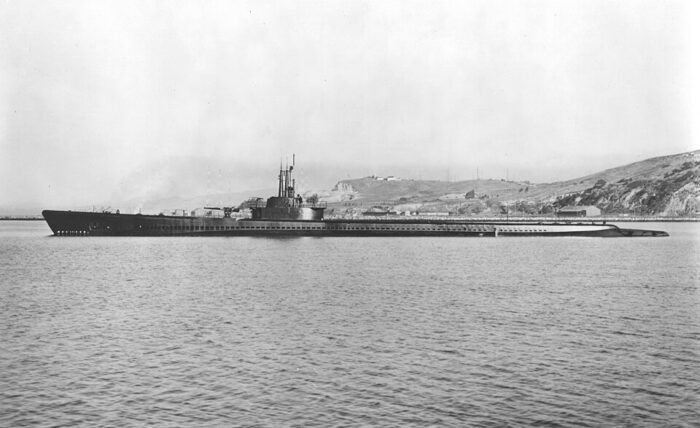
USS Tang off Mare Island, on trials by December 1943.
USS Tang laid down on 15 Jan 1943 at Mare Island, launched 17 Aug 1943 and commissioned on 15 Oct 1943 under Lieutenant Commander Richard O’Kane, former XO of the already famous USS Wahoo, in command. She was operational on 30 November 1943 and completed fitting out at Mare Island, then San Diego for 18 days of training, and headed for Hawaii, arrived on 8 January 1944 for two weeks of exercises. First patrol started on 22 January 1944 in the Caroline Islands and Mariana Islands area. On 17 February, she spotted two freighters, five smaller ships and escort. After the tracking, course plotting, and preparations to attack she was surprised by an escort suddenly coming at her at 7,000 yd (6,400 m) and closing fast, so she went deep and cashed in a few DCs. She returned to periscope depth, resumed the attack, closed to 1,500 yd (1,400 m), fired four and sank Gyoten Maru (6,800 tons) before escaping, running deep. Later she surfaced and tried to rush ahead of the convoy for a dawn attack but the convoy was out of range. The night of 22 February she surface attacked a convoy of three cargo, two escorts through rain squalls and took a firing position at 1,500 yd (1,400 m) of a freighter, fired four, claimed Fukuyama Maru (3,600 tons). Next day another convoy, she torpedoed the 6,800 ton Yamashimo Maru.
On 24 February, she sighted a tanker, freighter, and destroyer through Rain squalls and attacked after nightfall, surfaced, launched four and sank an unknown Tatutaki Maru-class freighter. After evasive actions she shadowed the convoy, surfaced, attacked a tanker from 500 yd (460 m) and claimed Echizen Maru. But escortts were hard at her. She went deep, passed her depth gauge maximum of 612 feet but was brought under control and later surfaced. On 26 February she spotted another convoy (freighter, transport, four escorts), missed one, but hit the other, Choko Maru (1794-ton) and went home at Midway for refit after spening 24 torpedoes for 16 hits, already the most successful first patrol.
In her second patrol from 16 March she went for the Palau-Davao Gulf-Truk routes. She made five surface contacts, no attacks. Assigned to lifeguard duty near Truk she rescued 22 downed airmen.
Her 3rd patrol started on 8 June in the East China Sea-Yellow Sea areas. On 24 June off Kagoshima, she spotted a convoy of six large ships with 16 escorts. Surfaced, she launched three torpedoes at one, three at a second target, reported two but postwar examination showed she claimed Tamahoko Maru, Tainan Maru, Nasusan Maru, and Kennichi Maru.
On 30 June, while between Kyūshū and Dairen, she spotted a lone cargo without escort, made an around run, surfaced, launched but missed. Later she surfaced, chased her until closed to 750 yd (690 m), sank Nikkin Maru with a single torpedo. She was carrying 3,200 Japanese soldiers.
On the 31th she spotted a tanker and freighter, sank Taiun Maru 2, but Takatori Maru 1 fled. She trailed her until dark, caught her, launched two and sank her. On 4 July she attacked a freighter near shore, drew back, fired three, two hits, the 6,886 ton Asukazan Maru. The same afternoon she spotted Yamaoka Maru, sank her with two torpedoes and rescued a survivor for interrogation. While off Dairen the next night she sighted a cargo, made a submerged attack with the last two torpedoes and claimed Dori Maru for a tally of 10 ships, 39,160 tons.
Her fourth war patrol started on 31 July, until 3 September 1944, in Japanese home waters, Honshū. On 10 August she fired three at a tankeroff Omaezaki, missed. Later she spotted two freighters and two escorts, launched three and claimed Roko Maru) and a second ship, but endured a depth charge attack for 38 minutes. On 14 August she deck gunned a patrol yacht and on the 22th she sank a 225 ft (69 m) patrol boat (No. 2 Nansatsu Maru). On 23 August she fired three, two hits and sank the 8,135 ton transport Tsukushi Maru. Two days later she attacked a tanker and escort with her last three torpedoes, sinking the tanker, No. 8 Nanko Maru, and headed back for Pearl Harbor.
Fifth patrol started after a refit, on 24 September, refuelling at Midway and heading for the Formosa Strait on 27 September, but passing through narrow waters, heavily patrolled then northeast from Formosa heavily mined. O’Kane was given the choice of attempting the passage north of the island alone, or joining Silversides, Trigger, and Salmon’s pack (John S. Coye, Jr., flag Silversides) northeast Formosa, making the passage with them. However he chose the first option. It was never heard from again.
Her fate had been reported by her surviving commanding officer:
She made the passage and on the night of 10–11 October, she sank Joshu Go and Ōita Maru. On 23 October she spotted a large convoy (3 tankers, a transport, a freighter plus escorts). O’Kane planned a night surface attack and managed to reach the middle of the formation, firing torpedoes on the tankers, all hit their targets. He spotted a tanker crossing her stern, a a transport bearing down on her to ram her, so she went deep but in the confusion still collided with tanker on her starboard quarter after firing four stern torpedoes from 400 yd (370 m). The tanker sank and she spotted the transport listing to 30°. Escorts arrived on her port bow while she tried to reach open water. When 6,000 yd (5,500 m) from the transport she assumed her sunk after the detonation. On 24 October, she patrolled at periscope depth, surfaced at dark to Turnabout Island until her search radar spotted a very a large convoy with tankers sporting planes on their decks, transports with crated planes for Taiwan. Their escorts however searched frantically with searchlights. Tang managed to spot large three-deck transport, smaller transport and large tanker and launched torpedoes to ranged between 900 to 1,400 yd (820 to 1,280 m). She continued parallel to the convoy to pick next victims, fired stern torpedoes at a transport and tanker aft but had to escape escort gunfire, being chased over by a destroyer which soon exploded, stroke by USS Tangs’s third torpedo. She later finished off a crippled transport from 240 ft (73 m), launched her 23rd torpedo from 900 yd (820 m), running straight, later confirmed as Kogen Maru (6,600 tons) and Matsumoto Maru (7,000 tons).
At 02:30 on 25 October she onl had her very last last torpedo, a brand new Mark 18. But spotters saw her broaching, curving to the left, and in their horror, seeing it making a circular run. Tang made an immediate emergency dive but it was too late. The torpedo struck her abreast the aft torpedo room, 20 seconds after fired. The pressure hull was torn open, floosing her whole aft section as she went down by the stern. In all loosing three compartments and the men in side. After this, only nine officers plus the bridge men and O’Kane survived and were able to swim through the night until, captured eight hours later. USS Tang settled under 180 ft (55 m). 30 survivors crowded into the forward torpedo room and prepared to use the forward escape trunk. Publications were burned but the escape was delayed by a Japanese patrol dropping depth charges. A, electrical fire in the forward battery forced to condemn yet another compartment. On 25 October Momsen lung were used for the first time. In all, thirteen men escaped from the forward torpedo room using these. The heat from the battery fire attacked the bulkhead. But of the men that escape the sub, only 5 were rescued. 78 men were lost. The escapees saw her bow was sticking out of the water, making her easy to see. O’Kane and 9 officers were picked by the Japanese frigate CD-34, and they were confonted with survivors of her previous sinkings. They took a serere beating. They ended in a prison camp at Ōfuna until V-Day and brutally interrogated.
Tang was stricken on 8 February 1945, on “Eternal Patrol”. Tang received four battle stars, two Presidential Unit Citations, Richard O’Kane, the MoH for a tally of 31 ships, 227,800 tons, unequaled among American submarines. JANAC reduced it to 24 ships, 93,824 tons, making her second after USS Tautog (26), fourth behind USS Flasher, Rasher, and Barb in tonnage. Today, this had been revised to 33 ships, 116,454 tons, first in the list again an her 3rd, the best patrol by number of ships sunk. She remained in icon to this day, and all donated items, are on display now on a permanent exhibition at the National World War II Museum in New Orleans.
 USS Tilefish SS-307
USS Tilefish SS-307
USS Tilefish was laid down at Marse Island Yard on 10 March 1943, launched on 25 Oct 1943, and commissioned on 15 Dec 1943. She was decommissioned on 12 Oct 1959,Fleet Snorkel1960, then transferred to Venezuela as Carite 4 May 1960, and stricken 1 Dec 1960, decommissioned by Venezuela for spare parts 28 Jan 1977.
 USS Apogon SS-308 (1943)
USS Apogon SS-308 (1943)
Apogon was laid down at Portsmouth Naval Shipyard, Kittery, Maine on 9 December 1942, launched on 10 March 1943 and commissioned on 16 July 1943. She was converted to remote control, sunk in Operation Crossroads nuclear weapons tests 25 Jul 1946, struck on 25 February 1947.
 USS Aspro SS-309 (1943)
USS Aspro SS-309 (1943)
Aspro was laid down at Portsmouth Naval Shipyard on 27 Dec 1942, launched on 7 Apr 1943, commissioned 31 Jul 1943. She was decommissioned on 30 Jan 1946. She was recommissioned between 23 September 1951 and 30 April 1954, and from 4 May 1957 to 7 September 1962: Auxiliary Transport (AGSS) on 1 July 1960, stricken on 7 Sept. 1962, and sunk as target 16 Nov 1962.
 Batfish SS-310 (1943)
Batfish SS-310 (1943)
Batfish was laid down 27 Dec 1942 at Portsmouth Naval Shipyard, 5 May 1943, and commissioned on 21 Aug 1943. She was decommissioned on 6 April 1946, recommissioned from 7 March 1952 to January 1960 and from January 1960, Auxiliary Transport (AGSS) 1 from December 1962, Pierside Trainer 1960-1969, and from 1 Nov. 1969, stricken became a memorial at Muskogee, Oklahoma.
 USS Archerfish SS-311 (1943)
USS Archerfish SS-311 (1943)

Archerfish was laid down a Portsmouth Naval Shipyard on 22 Jan 1943, launched on 28 May 1943 and commissioned on 4 Sept. 1943. She had shakedown training in November off New England, crossed the Panama Canal and headed directly to Pearl Harbor, arrived on the 29th. Zfter training there she departed for a 1st patrol on 23 December, via Midway Atoll on 27 December, refuelling and arrived north of Taiwan, attacking three ships (no kills) underway and back to Midway on 16 February 1944, then underway on 16 March for a 2nd patrol, spending 42 days at sea off the Palau Islands and back to Pearl Harbor via Johnston Island on 27 April. Post refit she left Pearl Harbor for the Bonin Islands, assigned lifeguard duty during the battle of Iwo Jima on 4 July, back to Midway on the 15th. After refit at the sub tender Proteus she departed on 7 August, sailed off Honshū and back to Pearl Harbor on the 29th (53 days).
Her 5th patrol in October–December 1944 was the most famous in an otherwise unremarkable career. Underway on 30 October under Joseph F. Enright via Saipan (9 November) she was assigned to lifeguard duties for the first B-29 strikes against Tokyofrom Iwo Jima. On the 28th the first raid was cancelled so she had carte blanche in the waters near Tokyo Bay.
Lookouts spotted a “tanker” leaving the bay, later identified as a large CV screened by destroyers Hamakaze, Yukikaze, Isokaze and submarine chaser Cha-241. This was IJN Shinano, the world’s largest aircraft carrier until USS Enteprise in 1960, in her maiden trials.
She truck her from ahead and after six hours, when Shinano turned back into her path, she submerged and fired six torpedoes, 4 hits, deliberately setting them to run shallow (10 ft or 3 m) and increase chances of a hit if it ran deeper (Mark 14 reputation). They hit between the anti-torpedo bulge and the waterline. USS Archerfish then dove to 400 ft (120 m) and waited. When surfacing to periscope depth later, Enright saw Shinano listing to starboard and pickup up loud breaking-up noises for 47 minutes. Despite her formidable ASW protection, the poorly trained crew was unable to prevent the carrier to sink. Archerfish ended in Guam on 15 December, after 48 days at sea. Initially, ONI did not believed her kill, until he was given credit postwar. This earned Enright a Navy Cross and the whole crew was awarded a Presidential Unit Citation.
Her Last two patrols were in January–September 1945. The first started on 10 January 1945 (sixth patrol) and Enright had been promoted wolfpack commander, named “Joe’s Jugheads” with Batfish and Blackfish. She was in the South China Sea, off Hong Kong and southern Formosa, damaging one unidentified target, claimed a submarine on 14 February. Her patrol ceased on 3 March due to bow-plane problems, via Saipan and Pearl Harbor, then San Francisco on 13 March, Hunters Point for overhaul. She sailed on 14 June for Pearl Harbor and departed for her 7th patorl on 10 July, on the east coast of Honshū, south coast of Hokkaidō for lifeguard services and still off Hokkaidō on 15 August. She was granted the right to enter Tokoy Bay for the ceremonies (only 12 submarines were present on 31 August, despite the role they provided in the Pacific campaign), moored alongside USS Proteus (AS-19), near the Yokosuka Navy Yard. On the 3th September she left for Pearl Harbor, (12 September), assigned to SubRon 1 for training and headed for San Francisco, then was in preinactivation overhaul. She was decommissioned on 12 June 1946, recommissioned from 7 March 1952 to 21 Oct 1955 and again between 1 August 1957, Auxiliary Transport (AGSS) on 22 Febuary 1960, and 1st May 1968 (struck), sunk as target 19 Oct 1968.
She earned seven battle stars.
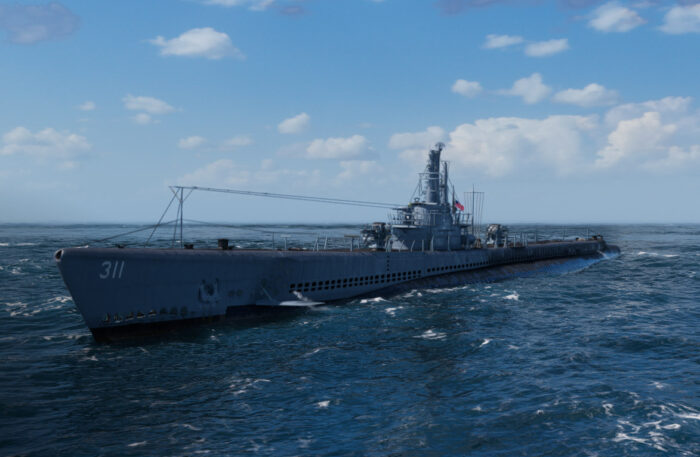
WoW’s impression of USS Archerfish
 USS Burrfish S-312 (1943)
USS Burrfish S-312 (1943)
Burrfish was laid down on 24 February 1943, launched on 18 June 1943, commissioned on 13 September 1943. She was decommissioned on 10 Oct 1946. Recommissioned from 2 November 1948, SSR from 1 February 1949, decommissioned on 17 Dec 1956, SS 15 Jan 1961, recommissioned on 17 January until 11 May 1961 and transferred to Canada as HCMS Grilse, returned to the US and struck on 19 July 1969, sunk as target on 19 November 1969.
 USS Perch SS-313 (1943)
USS Perch SS-313 (1943)
Perch was laid down at Electric Boat Company, Groton, Connecticut on 5 Jan. 1943, launched 12 September 1943, commissioned on 7 January 1944. She was decommissoned 15 January 1947. SSP 20 January 1948,, recommissioned from 20 May 1948, ASSP 31 Jan 1950, APSS 24 Oct 1956, decommissioned 31 Mar 1960, reommissioned on 11 Nov 1961. Recommissioned on 27 May 1967. Pierside Trainer 1967-1971, LPSS 1 Jan 1969, IXSS 30 Jun 1971, struck on 1 Dec. 1971, sold for scrap on 15 Jan 1973.
Shark was laid down at Electric Boat on 28 January 1943, launched on 17 October 1943, commissioned on 14 Febrary 1944. She was lost to Japanese surface attack, 24 Oct 1944.
 USS Sealion SS-315 (1943)
USS Sealion SS-315 (1943)

USS Sealion was laid down at Electric Boat on 25 February 1943, launched on 31 October 1943, commissioned 8 Mar 1944. Despite entering late into the Pacific war, she became one of the most successful US submarines. After shakedown she as assigned to SubDiv 222, Pearl Harbor operational by 17 May 1944 and training for three weeks, departing for a first patrol on 8 June with Tang, via Midway Atoll on 12 June. She hit a whale on 15 June. On the 22th she went through the Tokara Strait in the East China Sea and took station on the 23th off the Ōsumi Islands, Kyūshū. She soon had her first attack and depth charging. On 24 June Tinosa joined in and they sailed to the approaches to Sasebo, soon spotting a convoy on 25 June, but Sealion lost depth control and did not participated. They sailed to the Korean peninsula and on 28 June, Sealion sank Sansei Maru iff Tsushima Island. On 30 June she gunned down a sampan, and in July approached from Shanghai. On 6 July she spotted a convoy south of the Four Sisters Islands, claimed Setsuzan Maru sank but had to escape air and escort attacks.
Three days later she was off the Shandong peninsula and Korea in dense fog with her radar out of commission. On 11 July, she sank the Tsukushi Maru N°2 and Taian Maru N°2 and with her last torpedo, surfaced and tries to finish off the last freighter with 20 mm shells but she escaped. She headed back for Midway.
Refitted by USS Fulton, she sailed for Bashi Channel on 17 August (2nd patrol) with USS Growler and Pampanito, then South China Sea on 30 August and a day later surfaced to attack against a Japanese convoy, heavily damaging a tanker, Rikko Maru. She made another attack later and claimed the escorting torpedo boat Shirataka. She lkater misses a sub-hunter. Low on fuel and torpedoes she sailed for Saipan to rearm, refuel and on 7 September joined her attack group. On 10 September she was in Balintang Channel and on 12 September, the group gutted convoy to Formosa thanks to code breakers. Growler sank IJN Shikinami, Sealion missed and had to escaped but returned at 05:22, hit a tanker Rakuyo Maru, last ship, finished off Zuihō Maru, possibly and damaged Kachidoki Maru and later returned to finish off Rakuyo Maru and Kachidoki Maru (unfortunately they were hell ships and sank with 1,200 Australian and British POWs from Burma).
On 15 September, all three submarines reformed their scouting line. Soon they encountered many POWs. Sealion took on 54 POWs, sailed back to Saipan, 3 died en route. She was back to Pearl Harbor on 30 September and sailed for her 3rd patrol on 31 October with USS Kete, patrolling the East China Sea via Midway on 4 November. She crossed the Tokara Strait and on 16 November accidentally fired with both doors closed. On 17 November off Shanghai she looked for targets but a day later there was a hydrogen explosion in the battery space of the torpedo, in number 5 tube. Repairs were done.
On 21 November, she had radar contact with a formation hrough the Taiwan Strait at 16 knots, not zig-zagging. By 00:48 she spotted two cruisers and two battleships plus escorts (Yamato, Nagato, Kongō, Yahagi, Hamakaze, Isokaze, Urakaze, Yukikaze, Kiri, Ume). A golden opportunity, often only happening once in a submarine’s career. At 02:45 she was ahead of the task force, turned in, slowed for the attack and after 11 min. taking position, fired six torpedoes at Kongō, then later, three at Nagato. At 03:00 three hits. Kongō had two boiler rooms flooded, listing to port. Nagato, alerted, turned hard and dodged. But one hit and sank IJN Urakaze (magazines detonated). She sank with all hands and DesDiv 17, staff and commander Yokota Yasuteru.
Sealion was hunted down but reloaded, tracking again while the formation started zig-zagging and weather deteriorated then split at 04:50. She choosed the slowed down Kongō, Isokaze and Hamakaze, and finished off Kongō at 05:24. The whole attack was captured in a sound recorder left behind by a CBS war correspondent from Midway, later preserved by the Naval Underwater Sound Laboratory, as a unique piece. Sealion went on patrolling between Mainland China and Formosa but sailed on 28 November to Guam. Her 4th patrol started on 14 December 1944 in the South China Sea with USS Blenny and Caiman but in poor weather, 26 days spent mostly surfaced. On 20 December she spotted a supply ship and destroyer, fired 6 at 19:37, 4 hits, downed the supply ship.
Reassigned directly under the 7th Fleet she was in reconnaissance for the attack on the Philippines and headed for Fremantle (24 January 1945), departing fir her 5th patrol on 19 February in the South China Sea, Gulf of Siam, and on 17 March, sank Samui. On 2 April, she rescued an Army aviator and later 3 more downed aviators transferred from USS Guavinao. On 30 April she was at sea again with Bashaw and Hammerhead from Subic Bay for the South China Sea and in May, patrolled off Hong Kong with additional lifeguard services, received downed aviators from USS Bream and landed them at Subic before departing for Hawaii with passengers via Guam on 12 June, but taking lifeguard station off Wake. On 30 June, she left for Pearl Harbor, then San Francisco, for an overhaul, learning about the end of the war. She was inactivated after her overhaul on 2 February 1946. She was awarded the Presidential Unit Citation for her six war patrols, 5 battle stars.
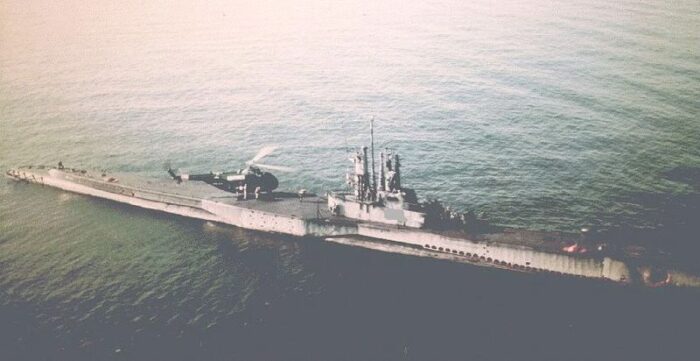
USS Sealion as the Navy’s Unique Helicopter-Accommodating Submarine in 1956. This was inspired by the Suez operation but not a success due to the small size of the helideck, only practicable in very calm weather. src
She was decommissioned on 16 Feb 1946, SSP 5 Apr 1948, recommissioned fom 2 November 1948, and until 30 Jun 1960. In between she was reassigned as ASSP on 31 January 1950, APSS on 24 October 1956, Pierside Trainer 1960-1961 (recommissioned on 20 October 1961). LPSS on 1 January 1969. She was decommissoned on 20 Febuary 1970, struck on 15 March 1977, she was a test hulk, and was sunk as target on 8 July 1978.
 USS Barbel SS-316 (1943)
USS Barbel SS-316 (1943)
Barbel was laid down 11 March 1943 at Electric Boat, launched on 14 Nov 1943, commissoned on 3 April 1944. She was lost to Japanese air attack on 4 February 1945.
 USS Barbero SS-317 (1943)
USS Barbero SS-317 (1943)
Barbero was laid down on 25 March 1943 at EB, launched on 12 December 1943, commissioned on 29 April 1944. She as decommissioned on 30 Jun 1950, but SSA 5 Apr 1948, ASSA 31 Jan 1950, SSG 25 Oct 1955; recommissioned from 28 October 1955 until 30 June 1964, struck on 1 July 1964, and sunk as target 7 Oct 1964.
 USS Baya SS-318 (1944)
USS Baya SS-318 (1944)
Baya as laid down at EB on 8 April 1943, launched on 2 Jan 1944, commissioned 20 May 1944. She was decommissioned on 14 May 1946. Recommissioned on 10 February 1948, Auxiliary Transport (AGSS) 16 Aug 1949 for sonar tests struck 30 Oct 1972, sold for scrap in October a year later.
 USS Becuna SS-319 (1944)
USS Becuna SS-319 (1944)
USS Becuna was laid down at EB on 29 April 1943, launched 30 January 1944, commissioned on 27 May 1944. She was converted as Guppy IA in 1951, recommissioned as Auxiliary Transport (AGSS) on 1st Oct. 1969, 7 November 1969, SS 30 June 1971, stricken 15 August 1973, memorial at Philadelphia.
 USS Bergall SS-320 (1944)
USS Bergall SS-320 (1944)
Bergall was laid down on 13 May 1943 at Electric Boat, launched on 16 February 1944. She was commissioned on 12 June 1944. She was reclassed asFleet Snorkelin 1952, decommissioned on 18 Oct 1958, transferred to Turkey on 18 Oct 1958 as Turgut Reis. Struck 15 Feb 1973, but decommissioned on 5 April 1983, renamed Ceryah Botu 6, receiving ship at Gölcük Naval Base until sold for scrap in 2000.
 USS Besugo SS-321 (1944)
USS Besugo SS-321 (1944)
Besugo was laid down on 27 May 1943 at EB yard, launched on 27 February 1944, and commissioned on 19 June 1944. She was decommissioned on 21 March 1958, reclassed as Auxiliary Transport (AGSS) on 1st December 1962,Fleet Snorkel1966, transferred to Italy on 31 March 1966 as Francesco Morosini. Returned to US custody, struck 15 Nov 1975, sold for scrap 16 April 1976.
 USS Blackfin SS-322 (1944)
USS Blackfin SS-322 (1944)
Blackfin was laid down at EB on 10 June 1943, launched on 12 March 1944, and commissioned on 4 July 1944. She was commissioned on 19 November 1948. She was recommionned after conversion as Guppy IA in 1951. In service as fleet snorkel from 15 May 1951 to 15 September 1972, struck and sunk as target on 13 May 1973.
 USS Caiman SS-323
USS Caiman SS-323
USS Caiman was laid down on 24 June 1943 at EB, Groton, launched on 30 March 1944, commissioned on 17 July 1944. She was converted as Guppy IA in 1951. In service until 30 June 1972 when sold to Turkey as Dumlupinar (S339). Decommissioned on 6 February 1983, renamed Ceryan Botu (Y-1247), as a battery charging hulk at Gölcük Naval Base. Sold for scrap on 15 September 1986.
 USS Blenny SS-324 (1944)
USS Blenny SS-324 (1944)
USS Blenny was laid down on 8 July 1943 at Electric Boat in Groton, launched on 9 April 1944, and commissioned on 27 July 1944. Converted as Guppy IA in 1951, Auxiliary Transport (AGSS) on 1 Oct. 1969, decommissioned on 7 November 1969, SS 30 June 1971, struck 15 August 1973 and scuttled 7 June 1989 as part of artificial reef near Ocean City, Maryland.
 Blower SS-325 (1944)
Blower SS-325 (1944)
Blower was laid down on 15 July 1943 at EB, launched on 23 April 1944, commissioned on 10 August 1944. She was FS, decommissioned on 16 Nov. 1950, transferred to Turkey on 16 November 1950 as Dumlupinar (D-6). She was struck on 20 Dec 1950, lost due to collision with MV Naboland on 4 April 1953.
 USS Blueback SS-326 (1944)
USS Blueback SS-326 (1944)
Blueback was laid down on 29 July 1943 at EB, launched on 7 May 1944, commissioned on 28 August 1944. She was decommissioned and transferred to Turkey on 23 May 1948 as Ikinci İnönü, struck on 28 May.Fleet Snorkel1953 and decommissioned on 30 Nov 1973, returned to US custody, fate unknown (probably scrapped).
 USS Boarfish SS-327 (1944)
USS Boarfish SS-327 (1944)
Boarfish was laid down on 12 August 1943 at EB, launched on 21 May 1944, commissioned on 23 September 1944. She was decommissioned and tranbsferred to Turkey on 23 May 1948 as Sakarya, struck on 28 May 1948,Fleet Snorkel1953. She was decommissioned by Turkey on 12 December 1975, returned to US custody and sold for scrap in 1980.
 Charr SS-328 (1944)
Charr SS-328 (1944)
Charr laid down on 26 August 1943 at EB, launched on 28 May 1944 and commissioned on 23 September 1944. She wasFleet Snorkel1951, Auxiliary Transport (AGSS) 1 July 1966, recommissioned 28 June 1969, Pierside Trainer 1969-1971, IXSS 30 Jun 1971 and struck on 20 December 1971, and sold for scrap on 17 August 1972.
 Chub SS-329 (1944)
Chub SS-329 (1944)
Chub was laid down on 16 September 1943 at EB, she was launched on 18 June 1944, commissioned on 21 October 1944. She was decommissioned 23 May 1948 and transferred to Turkey as Gür, struck 28 May 1948,Fleet Snorkel1953, decommissioned by Turkey on 12 Dec 1975, returned to US custody and sold for scrap on 22 May 1976.
 Brill SS-330 (1944)
Brill SS-330 (1944)
Brill was laid down on 23 September 1943 at EB, launched on 25 June 1944, commissioned on 26 October 1944. She was decommissioned on 23 May 1948. Transferred to Turkey as Birinci İnönü, struck 28 May 1948.Fleet Snorkel1953, decommissioned by Turkey on 29 Nov 1972, returned to US custody, fate unknown.
 Bugara SS-331 (1944)
Bugara SS-331 (1944)
Bugara was laid down on 21 October 1943 at EB, launched on 2 July 1944, commissioned on 15 November 1944.Fleet Snorkel1951, Auxiliary Transport (AGSS) 30 Jun 1969, SS 1 Oct 1969; struck 1 Oct 1970, slated to be sunk as target, but sank under tow 1 June 1971.
 Bullhead SS-332 (1944)
Bullhead SS-332 (1944)
Bullhead was laid down on 21 October 1943, launched on 16 July 1944 and commissioned on 4 December 1944. She was lost to Japanese air attack on 6 August 1945.
 Bumper SS-333 (1944)
Bumper SS-333 (1944)
Bumper was laid down on 6 November 1943 at EB, launched on 6 August 1944, and commissioned on 9 December 1944. She was decommissioned on 16 November 1950,Fleet Snorkel1950 and transferred to Turkey as Çanakkale, struck on 20 December and decommissioned on 8 Nov 1976, probably scrapped.
 Cabezon SS-334 (1944)
Cabezon SS-334 (1944)
Cabezon was laid down on 18 November 1943 at EB, launched on 27 Aug 1944 and commissioned on 30 December 1944. She was decommissioned on 24 October 1953. Auxiliary Transport (AGSS) on 1st December 1962, Pierside Trainer 1960-1970, struck 15 May 1970, sold for scrap 28 Dec 1971.
 Dentuda SS-335 (1944)
Dentuda SS-335 (1944)
Dentuda was laid down on 18 November 1943 at EB, launched on 10 September 1944, commissioned on 30 December 1944. Decommisssioned on 11 Dec 1946, disposed of Operation Crossroads tests in July 1946, Pierside Trainer 1946-1967, Auxiliary Transport (AGSS) 1 Dec 1962, struck on 30 Juny 1967, sold for scrap on 12 February 1969.
 Capitaine SS-336 (1944)
Capitaine SS-336 (1944)
Capitaine was laid down on 2 Dec. 1943, launched on 1 October 1944, commissioned on 26 January 1945. She was decommisioned 10 February 1950, Auxiliary Transport (AGSS) 1 July 1960,Fleet Snorkel1966, transferred to Italy 4 Mar 1966 as Alfredo Cappellini, then sold on 5 December 1977, fate unknown.
 USS Carbonero SS-337 (1944)
USS Carbonero SS-337 (1944)
Carbonero was laid down on 16 December 1943 at EB, launched on 15 October 1944, commissioned on 7 Febuary 1945. Loon missile test launcher in 1949.Fleet Snorkel1952, Auxiliary Transport (AGSS) 30 Jun 1969, SS 1 October 1969. Decommissioned on 1st December 1970, struck sunk as target on 27 April 1975.
 USS Carp SS-338 (1944)
USS Carp SS-338 (1944)
Carp was laid down on 23 December 1943, launched on 12 November 1944, and commissioned on 28 February 1945.Fleet Snorkel1952, Auxiliary Transport (AGSS) 1 May 1968. She was decommissioned on 18 March 1968, Pierside Trainer 1968-1971, IXSS 30 Jun 1971, struck 20 December 1971, sold for scrap on 26 Jul 1973.
 USS Catfish SS-339 (1944)
USS Catfish SS-339 (1944)
Catfish was laid down at EB on 6 January 1944, launched on 19 November 1944 and commissioned on 19 March 1945. Convrted as Guppy II in 1949. Struck and sold to Argentina on 1 July 1971 as Santa Fe (S-21): Damaged, grounded, abandoned after a helicopter air attack on 25 Apr 1982, scuttled on 10 February 1985.
 Entemedor SS-340 (1944)
Entemedor SS-340 (1944)
Entemedor was laid down on 3 February 1944 at EB, launched on 17 December 1944, and commissioned on 6 April 1945. Decommissioned on 10 December 1948. Converted as Guppy IIA in 1952, struck 24 Oct 1950, sold to Turkey on 31 Jul 1972 as Preveze, decommissioned on 20 March 1986, fate unknown.
 Chivo SS-341 (1945)
Chivo SS-341 (1945)
USS Chivo was laid down on 21 February 1944, launched on 14 January 1945, commissioned on 28 April 1945. Converted as Guppy IA in 1951, in service until struck, sold to Argentina on 1 July 1971 as Santiago del Estero (S-22). Decommissioned in January 1981, sold for BU in 1983.
 Chopper SS-342 (1945)
Chopper SS-342 (1945)
Chopper was laid down on 2 March 1944, launched on 4 February 1945 and commissioned on 25 May 1945. converted as GUPPY IA 1951, decom. 27 Aug 1969, Auxiliary Transport (AGSS) 15 Sep 1969, Pierside Trainer 1969-1971, IXSS 30 Jun 1971, struck 1 Oct. 1971, salvage and rescue hulk. She was sunk on 21 July 1976 while rigged as underwater target.
 USS Clamagore SS-343 (1945)
USS Clamagore SS-343 (1945)
USS Clamagore was laid down on 16 March 1944, launched on 25 February 1945, juned on 28 June 1945. She was decommissioned on 12 June 1973, Guppy II in 1948, Guppy III in 1962, stricken on 12 June 1975, since placed as memorial at Patriots’ Point, Mount Pleasant, in South Carolina.
 USS Cobbler SS-344 (1945)
USS Cobbler SS-344 (1945)
USS Cobbler was laid down on 3 Apr 1944, launched on 1 April 1945 and commissioned on 8 August 1945. She was decommissioned on 21 November 1973 (Guppy II 1949, Guppy III 1962), stricken and sold to Turkey on 21 Nov 1973 as Çanakkale, Decommissioned on 22 January 1998, fate unknown.
 Cochino SS-345 (1945)
Cochino SS-345 (1945)
USS Cochino was laid down on 13 April 1944, launched on 20 April 1945, commissioned on 25 August 1945. Converted as Guppy II in 1949. Lost due to battery fire on 26 August 1949.
 USS Corporal SS-346 (1945)
USS Corporal SS-346 (1945)
USS Corporal laid down on 27 April 1944, launched on 10 June 1945 and commissioned on 9 November 1945. She was converted as Guppy II 1948, Guppy III in 1962. She was decommissioned on 21 November 1973, struck and sold to Turkey as Ikinci İnönü, decommissioned on 2 September 1996, scrapped.
 USS Cubera SS-347 (1945)
USS Cubera SS-347 (1945)
Cubera was laid down on 11 May 1944, launched on 17 June 1945 and commissioned on 19 December 1945. She was converted as Guppy II in 1948. Strick on 5 January 1972, sold to Venezuela as Tiburon, decommissioned, sold for scrap in February 1987.
 USS Cusk SS-348 (1945)
USS Cusk SS-348 (1945)
Cusk was laid down on 25 May 1944, launched on 28 July 1945 and commissioned on 5 February 1946. She became an SSG (Loon missile test launcher) on 20 Jan 1948. She becameFleet Snorkel1954, SS 1 July 1954, Auxiliary Transport (AGSS) on 30 June 1969 and decommissioned on 24 September 1969. She was stricken and sold on 26 June 1972.
 USS Diodon SS-349 (1945)
USS Diodon SS-349 (1945)
Diodon was laid down on 1 June 1944, launched on 10 September 1945, commissioned on 18 March 1946. Converted as Guppy II in 1948, decommissioned and stricken 15 Jan 1971, sold for scrap 12 May 1972.
 Dogfish SS-350 (1945)
Dogfish SS-350 (1945)
Dogfish was laid down on 22 June 1944, launched on 27 Oct 1945, commissioned on 29 April 1946. She was converted as Guppy II in 1948. She as stricken on 28 July 1972 and sold to Brazil (name ?), decommissoned and sold for scrap 1983.
 USS Greenfish SS-351 (1945)
USS Greenfish SS-351 (1945)
Greenfish was laid down on 29 June 1944, launched on 21 December 1945, commissioned on 7 June 1946. She was converted as Guppy II in 1948, Guppy III in 1961. She was decommissioned on 19 December 1973, and sold to Brazil as Amazonas, struck on 15 Oct 1992, sold for BU on 30 January 2004.
 USS Halfbeak SS-352 (1946)
USS Halfbeak SS-352 (1946)
Halfbeak was laid down on 6 July 1944, launched on 19 Feb 1946 and commissioned on 22 Jul 1946. Converted as Guppy II in 1948. She was stricken on 1 July 1971, sold for scrap 13 June 1972.
 USS Hardhead SS-365 (1943)
USS Hardhead SS-365 (1943)
Hardhead SS-365 was the first laid down at Manitowoc Shipbuilding Company in Wisconsin, on 7 July 1943. She was launched on 12 December 1943, commissioned on 18 April 1944. She was decommissioned on 10 May 1946, converted as Guppy IIA in 1953, struck, sold to Greece on 26 July 1972 as Papanikolis, decommissioned by Greece on 31 December 1992, fate unknown.
 USS Hawkbill SS-366 (1944)
USS Hawkbill SS-366 (1944)
Hawkbill on lid down on 7 August 1943, launched on 9 January 1944, commissoned on 17 May 1944. Decommissioned on 20 Sep 1946. Converted as Guppy IB in 1952, transferred to the Netherlands on 21 Apr 1953 as Zeeleeuw, struck, 20 Ferbuary 1970, sold for BU 24 Nov 1970.
 USS Icefish SS-367 (1944)
USS Icefish SS-367 (1944)
Icefish was laid down on 4 September 1943, launched on 20 February 1944, commissioned on 10 June 1944. She was decommisioned on 21 June 1946. Converted as Guppy IB 1952. She was transferred to the Netherlands on 21 February 1953 as HNLMS Walrus. She was returned to US custody, stricken on 15 July 1971, sold for scrap on 15 August 1971.
 USS Jallao SS-368 (1944)
USS Jallao SS-368 (1944)
Jallao was laid down on 29 September 1943, launched on 12 March 1944, commissioned on 8 Jul 1944. She was decommissioned on 30 September 1946. She was converted as Guppy IIA in 1954. Struck and sold to Spain on 26 June 1974 as Narcíso Monturiol (S-35). She was decommissioned by Spain on unknown date, scuttled on 31 December 1984.
 USS Kete SS-369 (1944)
USS Kete SS-369 (1944)
USS Kete was laid down on 25 October 1943, launched on 9 April 1944, commissioned on 31 Jul 1944. Lost, possibly to Japanese submarine attack or mine in March 1945.
 USS Kraken SS-370 (1944)
USS Kraken SS-370 (1944)
Kraken was laid down on 13 December 1943, launched on 30 April 1944 and commissioned on 8 September 1944. She was decommissioned on 4 May 1948,Fleet Snorkel1959; transferred (loaned) to Spain 24 Oct 1959 as Almirante García de los Reyes, decommissioned on 16 Sep 1974 but sold on 1 November recommissioned on 1 September 1975 renamed Narciso Monturiol (S-33), and decommissioned for good on April 1981, sold for scrap 1 Apr 1982.
 Lagarto SS-371 (1944)
Lagarto SS-371 (1944)
Lagarto was laid down on 12 January 1944, launched on 28 May 1944 and commissioned on 14 October 1944. She was lost to a Japanese surface attack on 4 May 1945.
 Lamprey SS-372 (1944)
Lamprey SS-372 (1944)
Lamprey was laid down on 28 February 1944, launched on 18 Jun 1944 and commissioned on 17 November 1944. She was decommissioned on 3 June 1946. She was transferred to Argentina on 21 August 1960 as Santiago del Estero. She was struck and sold to Argentina 1 September 1971, and scrapped for spare parts.
 Lizardfish SS-373 (1944)
Lizardfish SS-373 (1944)
Lizardfish was laid down on 14 March 1944, launched on 16 July 1944, commissioned on 30 December 1944. She wasFleet Snorkel1959, decom. on 24 June 1946 transferred under MDAP to Italy on 9 January 1960 as Evangelista Torricelli. Stricken on 1st July 1976, 15 July 1978.
 Loggerhead SS-374 (1945)
Loggerhead SS-374 (1945)
Loggerhead was laid down as 1 April 1944, launched on 13 August 1944 and commissioned on 9 February 1945. She was decommissioned on 16 June 1946. Pierside Trainer 1960-1967, Auxiliary Transport (AGSS) 1 Dec 1962, struck on 30 June 1967, sold for scrap 29 Aug 1969.
 Macabi SS-375 (1944)
Macabi SS-375 (1944)
Macabi was laid down on 1 May 1944, launched on 19 September 1944, commissioned on 29 March 1945. She was decommissioned on 16 June 1946. She was transferred to Argentina on 11 Aug 1960 as Santa Fe (S-11), sold on 1 September 1971, scrapped for spare parts 1972.
 USS Mapiro SS-376 (1944)
USS Mapiro SS-376 (1944)
Mapiro was laid down on 30 May 1944, launched on 9 November 1944, commissioned on 30 Apr 1945. She was decommissioned on 16 Mar 1946.Fleet Snorkel1960, transferred to Turkey 18 March 1960 as Pirireis, stricken, sold to Turkey 1 August 1973. She was decommissioned on 20 November 1973. She was used as battery charging hulk through 1975 before being sold for scrap in 1980.
 USS Menhaden SS-377 (1944)
USS Menhaden SS-377 (1944)
Menhaden was laid down 21 June 1944, launched on 20 December 1944, commissioned on 22 June 1945. She was decommissioned on 31 May 1946. Recommissioned from 7 August 1951 to 13 August 1952 and converted to a GUPPY IIA in 1953, in service from 6 March 1953 to 13 August 1971, struck 15 Aug 1973, underwater target 1976 and sold for scrap in 1988.
 USS Mero SS-378 (1945)
USS Mero SS-378 (1945)
USS Mero SS-378 was laid down on 22 July 1944, launched on 17 January 1945, commissioned 17 August 1945. She was decommissioned on 15 June 1946. Then commissioned from 29 December 1959 to 20 April 1960.Fleet Snorkel1960 and transferred to Turkey 20 April 1960 as Hizi Reis, sold 1 August 1973 and sold for scrap 9 October 1980.
 USS Sand Lance SS-381 (1943)
USS Sand Lance SS-381 (1943)
USS Sand Lance was laid down at Portsmouth Naval Shipyard (second batch) on 12 March 1943, launched on 25 June 1943 and commissioned on 9 October 1943. She was decommissioned on 14 February 1946. She was recommissioned between 6 April 1963 and 7 September 1963, Transferred that day to Brazil as Rio Grande do Sul, struck 1 September 1972, returned on 12 October 1972, sold for scrap on 1st June 1974.
 Picuda SS-382 (1943)
Picuda SS-382 (1943)
USS Picuda SS-382 was laid down at Portsmouth Naval Shipyard, Kittery, Maine 15 March 1943, launched on 12 July 1943, commissioned on 16 October 1943, decommissioned 25 September 1946. Proposed for minelayer conversion, cancelled in 1952. Converted instead as GUPPY IIA in 1953, she was transferred under MDAP to Spain on 1st October 1972 as Narcíso Monturiol, sold on 18 November 1974, decommissioned by Spain on 30 April 1977, fate unknown.
 USS Pampanito SS-383 (1943)
USS Pampanito SS-383 (1943)
Pampanito SS-383 was laid down at Portsmouth Naval Shipyard, Kittery, Maine on 6 November 1943, launched on 15 December 1945. She became Pierside Trainer 1960-1971. Commission April 1960 to 20 Dec 1971 and in between Auxiliary Transport (AGSS) 1 Dec 1962, IXSS 30 Jun 1971 and struck on 20 December 1971, became a memorial in San Francisco.
 Parche SS-384 (1943)
Parche SS-384 (1943)
Parche was laid down at Portsmouth Naval Shipyard, Kittery, Maine on 9 April 1943, launched on 24 July 1943, commissioned 20 November 1943. 11 December 1946. She was a target in Operation Crossroads for the tests July 1946,
recommissioned from 10 February 1948, Pierside Trainer 1948-1969 (Auxiliary Transport (AGSS) 1 Dec 1962). Struck 8 November 1969, sold for scrap 18 June 1970.
 Bang SS-385 (1943)
Bang SS-385 (1943)
Bang was laid down at Portsmouth Naval Shipyard, Kittery, Maine on 30 April 1943, launched on 30 August 1943, commissioned on 4 December 1943. She was decommissioned on 12 February 1947. Recommissioned from 1st February 1951 until the 15 May 1952, converted as GUPPY IIA in 1952, recommissioned on 4 October. On 1 October 1972 she was transferred to Spain unde MDAP as Cosme García, sold 18 November 1974 and decommissioned; sold for scrap on 30 December 1982.
 USS Pilotfish (SS-386)
USS Pilotfish (SS-386)
Pilotfish was laid down at Portsmouth Naval Shipyard, Kittery, Maine on 15 May 1943, launched on 30 August 1943, commissioned on 16 December 1943. She was decommissioned on 29 August 1946. Sunk in Operation Crossroads on 25 July 1946, later raised but struck on 25 Febuary 1947, sunk as target on 16 October 1948 over deep water.
 Pintado SS-387 (1943)
Pintado SS-387 (1943)
USS Pintado was laid down at Portsmouth Naval Shipyard, Kittery, Maine on 7 May 1943, launched on 15 September 1943 and commissioned on 1 January 1944. She was decommissioned on 6 March 1946. Converted as Auxiliary Transport (AGSS) 1 December 1962 and struck on 1 March 1967, sold for scrap on 19 February 1969.
 Pipefish SS-388 (1943)
Pipefish SS-388 (1943)
Pipefish wa slaid down at Portsmouth Naval Shipyard, Kittery, Maine on 31 May 1943, launched on 27 October 1943 and commissioned on 22 January 1944. She was decommissioned on 19 March 1946. She became Auxiliary Transport (AGSS) on 1st Deemberc 1962 until struck on 1 March 1967, sold for scrap on 4 Febuary 1969.
 USS Piranha SS-389
USS Piranha SS-389
USS Piranha was laid down at Portsmouth Naval Shipyard, Kittery, Maine on 21 June 1943, launched on 27 October 1943, commissioned on 5 February 1944. She was decommissioned on 31 May 1946, converted as Auxiliary Transport (AGSS) on 1st December 1962 and struck on 1 March 1967, sold on 11 August 1970.
 USS Plaice SS-390 (1943)
USS Plaice SS-390 (1943)
USS Plaice SS-390 was laid down at Portsmouth Naval Shipyard, Kittery, Maine on 28 June 1943, launched on 15 November 1943 and commissioned on 12 February 1944. She was decommissoned on november 1947, mothballed. Transferred to Brazil on 7 September 1963 as Bahia, sold and struck on 1 April 1973, sold for scrap in 1978 after Brazilian preservation efforts failed.
 USS Pomfret SS-391 (1943)
USS Pomfret SS-391 (1943)
Pomfret was laid down at Portsmouth Naval Shipyard, Kittery, Maine on 14 July 1943, launched on 27 October 1943 and commissioned on 19 Febuary 1944. She was decommissioned in April 1952, converted as a GUPPY IIA into 1953. In US service from 5 December 1952 to 1 July 1971. Transferred to Turkey on 1 July 1971 as Oruç Reis, sold on 1 August 1973, decommissioned on 15 Sep 1986, probably scrapped.
 USS Sterlet SS-392 (1943)
USS Sterlet SS-392 (1943)
Sterlet was laid down at Portsmouth Naval Shipyard, Kittery, Maine on 14 July 1943, launched 27 October, completed on 4 March 1944. Decommissioned on 18 September 1948. Recommissioned between 26 August 1950 and 30 September 1968 (FS 1952, tested the BQR-4 bow sonar in 1955). Struck on 1 Octover 1968 and sunk as target on 31 January 1969.
 USS Queenfish SS-393 (1943)
USS Queenfish SS-393 (1943)
Queenfish was laid down at Portsmouth Naval Shipyard, Kittery, Maine, on 27 July 1943, launched on 30 November 1943 and completed on 11 March 1944. Auxiliary Transport (AGSS) on 1 July 1960, stricken 1 March 1963; sunk as target on 14 August.
 Razorback SS-394 (1944)
Razorback SS-394 (1944)
Razorback was laid down at Portsmouth Naval Shipyard, Kittery, Maine, on 9 September 1943, launched on 27 January 1944, completed on 3 April 1944. Decommissioned on August 1952. Converted as a GUPPY IIA in 1954, in US sevrice from January 1954 to 30 November 1970 and struck, sold to Turkey on 30 November 1970 as Murat Reis, decommissioned on 8 August 2001, repatriated to the US and preserved as memorial in North Little Rock, Arkansas.
 Redfish SS-395 (1944)
Redfish SS-395 (1944)
USS Redfish was laid down at Portsmouth Naval Shipyard, Kittery, Maine on 9 Sep 1943 (3 boats the same day), launched on 27 Jan 1944 (4 boats the same day), commissioned on 12 April 1944. She became an Auxiliary Transport (AGSS) on 1 July 1960, stricken on 27 June 1968 and struck on 30 June, sunk as target on 6 Feb 1969.
 Ronquil SS-396 (1944)
Ronquil SS-396 (1944)
Ronquil was laid down on 22 Apr 1944 at Portsmouth Naval Shipyard. Launched on 27 January 1944 and commissioned on 22 April. She was decommissioned on 1st May 1952, converted as GUPPY IIA in 1953, in service untl struck and transferred to Spain on 1 July 1971 as Isaac Peral, struck in 1982, likely scrapped.
 Scabbardfish SS-397 (1944)
Scabbardfish SS-397 (1944)
Scabbardfish was laod down at Portsmouth on 27 September 1943, launched on 27 January and commissioned on 29 April 1944. Decommissioned on 5 January 1948. Commissioned 24 October 1964 to 26 February 1965.Fleet Snorkel1965 and transferred to Greece on 26 February 1965 as Triaina, sold on 31 January 1976. Decommissioned on 12 January 1979, training boat until 1982, scrapped.
 Segundo SS-398
Segundo SS-398
Segundo was laid down on 14 Oct 1943 at Portsmouth, launched on 5 February 1944, commissioned on 9 May 1944. She was decommissioned on 1 August 1970,Fleet Snorkel1951 and stricken on 8 August 1970, sunk as target.
 Sea Cat SS-399 (1944)
Sea Cat SS-399 (1944)
Sea Cat wa slaid down at Portsmouth on 30 October 1943, launched on 21 Febuary 1944 and completed on 16 May. She was reclassified as Auxiliary Transport (AGSS) on 30 September 1949, SS 11 by December 1951,Fleet Snorkelin 1952, then Auxiliary Transport (AGSS) on 29 June 1968 and decommissioned on 2 December 1968, struck on 2 December 1968, test hulk on 1968-1972, sold for scrap 18 May 1973.
 USS Sea Devil (1944)
USS Sea Devil (1944)
Sea Devil was laid down at Portmouth Yard on 18 November 1943, launched on 28 February 1944 and commissioned on 24 May 1944. Decommissioned on 9 September 1948. Recommissioned from 3 March 1951 until 19 Febuary 1954. Recommissioned from 17 Aug 1957 to 17 Febuary 1964 and Auxiliary Transport (AGSS) from 1st July 1960. Struck on 1 April 1964 and sunk as target on 24 November 1964.
 USS Sea Dog SS-401 (1944)
USS Sea Dog SS-401 (1944)
USS Sea Dog was laid down at Portsmouth NyD on 1 November 1943, launched on 28 March 1944 and commissioned on 3 June 1944. She was decommissioned on 27 June 1956. Recommissioned from 1960 to 1968 and reclassified as Auxiliary Transport (AGSS) on 1 Dec. 1962, PT, struck 2 Dec 1968, sold for scrap on 2 Jan 1971, but sunk as target on 18 May 1973.
 USS Sea Fox SS-402 (1944)
USS Sea Fox SS-402 (1944)
USS Sea Fox was laid down on 2 November 1943, launched on 28 Machr 1944 (2 boats), completed on 13 June 1944. Decommissioned on 15 Oct. 1952 converted as GUPPY IIA in 1953, stricken and sold to Turkey on 14 December 1970 as Burak Reis. Decommissioned on 1st July 1996, became a battery charging hulk until sold for scrap in 2003. So probably the oldest Balao in service.
 USS Atule SS-403 (1944)
USS Atule SS-403 (1944)
Atule was laid down at Posrtmouth NyD on 2 December 1943, launched on 6 March 1944 and commissioned on 21 June. Decommissoned on 8 September 1947, mothballed. Converted as GUPPY IA and recommissioned on 8 Mar 1951 until 6 Apr 1970. Reclassed as Auxiliary Transport (AGSS) on 1 Oct. 1969 and SS 30 on June 1971. Struck on 15 August 1973 and sold to Peru on 31 Jul 1974 as Pacocha. Lost in a collision on 26 August 1988. Raised on 23 July 1989 but cannibalized for spare parts, scrapped.
 Spikefish SS-404 (1944)
Spikefish SS-404 (1944)
Spikefish was laid down on 29 January 1944 at Portsmith NyD, launched on 26 April 1944 and commissioned on 30 June 1944. Auxiliary Transport (AGSS) from 1st July 1962, Decommissoned on 2 April 1963, struck on 1 May 1963, sunk as target on 4 August 1964.
 USS Sea Owl SS-405 (1944)
USS Sea Owl SS-405 (1944)
USS Sea Owl was laid down at Portsmouth NyD on 7 February 1944, launched on 7 May 1944 and commissioned on 17 July 1944.Fleet Snorkel1951, BQR-4 bow sonar test boats from 1955, Auxiliary Transport (AGSS) from 30 Jun 1969 but decommissioned on 15 November 1969, struck on 15 November 1969, sold for scrap on 3 June 1971.
 USS Sea Poacher SS-406 (1944)
USS Sea Poacher SS-406 (1944)
Sea Poacher was laid down at Portsmouth NyD on 23 February 1944, launched on 20 May 1944 and commissioned on 31 July 1944. Converted as GUPPY IA in 1952, equipped with the BQR-4 bow sonar in 1955. She was decommissioned on 15 November 1969 while an Auxiliary Transport (AGSS) 1. Became a SS on 30 June 1971 but struck on 15 August 1973. Sold to Peru on 1 July 1974 as Pabellion de Pica, then La Pedrera, demoted to pierside training (PT) from 1995, scrapped.
 USS Sea Robin SS-407 (1944)
USS Sea Robin SS-407 (1944)
Sea Robin was laid down at Portsmouth NyD on 1st March 1944, launched on 25 May 1944, commissioned on 7 August 1944. Converted as GUPPY IA in 1951. Active until decommisionned on 1st October 1970, stricken on 1 October 1970 and sold for scrap on 3 June 1971.
 USS Sennet SS-408 (1944)
USS Sennet SS-408 (1944)
USS Sennet was laid down on 8 March 1944 at Posrtmouth launched on 6 June 1944 and commissioned on 22 August 1944. She became Fleet Snorkel in 1952. Decommissioned on 2 December 1968 and struck on 2 December 1968, sold for scrap on 15 June 1973.
 USS Piper SS-409 (1944)
USS Piper SS-409 (1944)
Piper was laid down on 15 Mar 1944 at Portsmouth, launched on 26 June and completed on 23 August 1944 (6 months). Fleet Snorkel in 1951, BQR-4 bow sonar boat in 1954, Auxiliary Transport (AGSS) from 15 June 1967, deactivated from 16 June 1967, Pierside Trainer until struck on 1st July 1970, sold for scrap in June 1971.
 USS Threadfin SS-410 (1944)
USS Threadfin SS-410 (1944)
USS Threadfin was laid down at Portsmouth NyD (last by that yard) on 18 March 1944, launched on 26 Jun 1944 (2 boats) and commissioned on 30 August 1944. She was decommissioned on 10 December 1952 from conversion as GUPPY IIA, completed on 7 August 1953. Transferred to Turkey on 18 Aug 1972 as Birinci İnönü. Struck on 1st August 1973, sold on the 18th. Decommissioned on 11 August 1998, probably scrapped.
 USS Spadefish SS-411 (1944)
USS Spadefish SS-411 (1944)

USS Spadefish was laid down at Mare Island Naval Shipyard in Vallejo, California on 27 May 1943, launched on 8 January 1944, completed on 9 March 1944 under command of LtCdr Gordon W. Underwood. After an abbreviated shakedown training off California, USS Spadefish departed San Francisco on 14 June for Pearl Harbor (22 June) for local training, and departed on 23 July, for a maiden war patrol with Picuda (SS-382) and Redfish (SS-395). On 19 August in Philippine waters, NW of Luzon, she torpedoed and sank the 9,589-ton, passenger-cargo ship Tamatsu Maru. On the 22th she trailed and attacked three large tankers through Babuyan Channel and claimed the 10,023-ton tanker Hakko Maru No. 2, damaging another. On the 23th she triled to attack the escort of the damaged tanker and withdrew for Tanapag Harbor in Saipan to take supplies. On 8 September in Nansei Shoto when she spotted eight cargo ships and fired during the night all 20 torpedoes, sinking the Nichiman Maru, Nichian Maru, Shinten Maru, and Shokei Maru, damaging another. The next morning, she fired her late four torpedoes at an escort guarding the latter but missed. She followed the convoy to Ishigaki harbor, and sailed for Pearl Harbor, arrived on 24 September. The wolfpack in total sank 13 ships, 64,000+ tons of shipping.
Her second war patrol started in October and on the 23th she departed with Sunfish (SS-281) and Peto (SS-265 for the Yellow Sea. On 14 Novembe she sank the Gyokupy Maru. On the 17th, she spotted an enemy convoy coming her way, let it pass overhead, surfaced after darkness, fired 6 and scred on the carrier IJN Shin’yō, then 4 stern tubes at a tanker. She only damaged the latter, but the carrier was a definitive kill. Later that night she fired four stern torpedoes at Sub Chaser No. 156. and sank her. On 29 November she sank the 3,760-ton cargo ship Daiboshi Maru No. 6 and ended in Majuro Atoll, Marshalls on 12 December.
Her 3rd patrol started after some R&R at Majuro, from 6 January 1945 with Pompon (SS-267), Atule (SS-403), and Jallao (SS-368), also in the Yellow Sea. She was mistook by two USMC Dauntless from VMSB-245, receiving two depth charges off Majuro but only had superficial damage. On 28 January she launched two spreads of torpedoes at a convoy, claimed the 7,158-ton converted seaplane tender Sanuki Maru and frigate Kume. On 4 February she bagged the passenger-cargo ship Tairai Maru. On the 6th off Port Arthur, she sank the 1,092-ton passenger-cargo ship Shohei Maru. She was back to Guam on 13 February. Her 4th patrol started on 15 March 1945, for the East China Sea and Yellow Sea. On 21 March she was again mistakenly attacked by an US aircraft, missed by 45 feet (14 m). The crew later collected bomb fragments on deck. On 23 March 1945, she passed four escorts to sink the 2,274-ton cargo ship Doryo Maru. Off Kyūshū, she sailed north to Tsushima Strait weary of minefields, gunned down a schooner off Korea on 1 April ad later a three-masted junk on 7 April. On the 9th she sank the Lee Tung, on the 11th she damaged a minesweeper and ended back in Guam on 21 April. Her 5th war patrol started after an overhaul in June, equipped with a mine-detecting device, to go through the heavily mined Tsushima Strait and enter the Sea of Japan. On 10 June off Tarukawa Wharf she sank the Daigen Maru No. 2, and later the Unkai Maru No. 8 and Jintsu Maru. On 12 June 1945 she gunned down a motor sampan with AA fire and then three trawlers. On 13 June she mistakenly sank the Soviet SS Transbalt. On 14 June, she sank the Seizan Maru and on 17 June, the C.M. minelayer Eijō Maru, to be back to Pearl Harbor on 4 July 1945.
She was still there on 15 August 1945, remained at Pearl until 2 September and sailed for Mare Island to be decommissioned, placed in reserve. Four battle stars. Decommissioned on 3 May 1946. Reclassified as Auxiliary Transport (AGSS) on 1st Dec. 1962, struck on 1 April 1967, sold for scrap on 17 October 1969.
 USS Trepang SS-412 (1944)
USS Trepang SS-412 (1944)
USS Trepang was laid down at Mare Island on 25 June 1943, launched on 23 March and completed on 22 May 1944. She was decommissioned on 27 June 1946. Pierside Trainer from February 1960 to 1967. Reclassed already Auxiliary Transport (AGSS) on 1 December 1962 and struck on 30 June in 1967, sunk as target on 16 September 1969.
 Spot SS-413 (1944)
Spot SS-413 (1944)
Spot was laid down on 24 August 1943 at Mare Island, launched on 19 May 1944 and completed on 3 August 1944. Decommissioned on 19 June 1946 and mothballed. Transferred to Chile on 12 January 1962 as Simpson, sold for good on 1 August 1975, decommissioned in 1982, likely scrapped.
 Springer SS-414 (1944)
Springer SS-414 (1944)
Springer was laid down on 30 October 1943, launched on 3 August 1944 and commissioned on 18 October 1944. She was decommissioned on 26 June 1946. Transferred to Chile on 23 January 1962 as Thomson. Sold o Chile 1 Sep 1972, deleted by Chile on unknown date, sold for scrap
 Stickleback SS-415 (1945)
Stickleback SS-415 (1945)
Stickleback was laid down on 1st March 1944, launched on 1st January 1945, completed on 29 March. Decommissioned on 26 June 1946. Active from 6 Sep 1951 to 14 Nov 1952. Converted as GUPPY IIA in 1953, reocmmissoned on 26 June. Lost in a collision with USS Silverstein (DE-534) on 28 May 1958.
 Tiru SS-416 (1947)
Tiru SS-416 (1947)
Tiru was the last laid down at Mare Island, on 17 April 1944, construction suspended, resumed, launched on 16 September 1947. Commissioned on 1 September 1948, completed as GUPPY II, then prototype GUPPY III in 1959. Active until struck on 1 July 1975, sunk as target on 19 July 1979.
 Trumpetfish SS-425
Trumpetfish SS-425
Trumpetfish was the first of 10 boats ordered at Cramp Shipbuilding Company, Philadelphia, Pennsylvania. She was laid down on 23 August 1943 but launched on 13 May 1945, commissioned delayed until 29 January 1946, converted as GUPPY II, completed by 1948. Converted as GUPPY III in 1962. Active until stricken on 15 October 1973. Sold to Brazil on 15 October 1973 as Goias, stricken on 16 April 1990.
 Tusk SS-426 (1946)
Tusk SS-426 (1946)
Tusk was laid down on 8 July 1945 at Cramp, completed on 11 April 1946. Converted as GUPPY II in 1948. Active until stricken on 18 October 1973, sold to Taiwan as Hai Pao, listed in service.
USS Turbut (SS-427) and Ulua (SS-428) were laid down on 13 November 1943. Cancelled, construction suspended on 12 August 1945. Launched delayed until 12 and 23 April 1946 to clear the slips, still incomplete. Turbot became a Machinery test hulk at Annapolis, MD, sold for scrap 24 Mar 1993 whereas Ulua became an ordnance test hulk at Norfolk in 1951-1958, struck on 12 June 1958, sold for scrap on 30 September 1958. Unicorn, Vendace, Walrus, Whitefish, Whiting, Wolffish (SS-429-434) were Cancelled on 29 July 1944, for the new Tench class. Same for the last to Electric boat SS-438 to 457, Maiwotoc series (SS-458 to SS-463 and SS-465 to SS-474 plus USS Chicolar as SS-464). Same also for SS-530 to SS-536 from Cramp.
Sources:
Books
Bauer, K. Jack; Roberts, Stephen S. (1991). Register of Ships of the U.S. Navy, 1775-1990: Major Combatants. Westport, Connecticut: Greenwood Press.
Blair, Clay Jr. (2001). Silent Victory: The U.S. Submarine War Against Japan. Naval Institute Press.
Friedman, Norman (1995). U.S. Submarines through 1945: An Illustrated Design History. Annapolis, Maryland: United States Naval Institute.
Friedman, Norman (1994). U.S. Submarines since 1945: An Illustrated Design History. Annapolis, Maryland: United States Naval Institute.
Alden, John D., Commander (U.S. Navy Ret) (1979). The Fleet Submarine in the U.S. Navy: A Design and Construction History. NIP
Bauer, K. Jack; Roberts, Stephen S. (1991). Register of Ships of the U.S. Navy, 1775–1990: Major Combatants. Greenwood Press.
Blair, Clay Jr. (2001). Silent Victory: The U.S. Submarine War Against Japan. Naval Institute Press.
Fluckey, Eugene B. (1992). Thunder Below: The USS Barb Revolutionizes Submarine Warfare in World War II. University of Illinois Press.
Friedman, Norman (1995). U.S. Submarines Through 1945: An Illustrated Design History. Annapolis, Maryland: United States Naval Institute.
Friedman, Norman (1994). U.S. Submarines Since 1945: An Illustrated Design History. Annapolis, Maryland: United States Naval Institute.
Gardiner, Robert; Chesneau, Roger (1980). Conway’s All the World’s Fighting Ships 1922–1946. Conway Maritime Press.
Hutchinson, Robert (2001). Jane’s submarines : war beneath the waves from 1776 to the present day. London: HarperCollins.
Johnston, David L. (2024). “A Visual Guide to the U.S. Fleet Submarines Part Four: Gato Class (With a Tambor/Gar Class Postscript) 1941–1945” (PDF).
McFarlane, Suzanne (23 August 2017). “Tunny I (SS-282)”. Dictionary of American Naval Fighting Ships. Navy Department, Naval History and Heritage Command.
O’Kane, Richard (1987). Wahoo – The Patrols of America’s Most Famous WWII Submarine. Presidio Press.
Roscoe, Theodore (1949). United States Submarine Operations in World War II. Naval Institute Press.
Silverstone, Paul H. (1989) [1965]. U.S. Warships of World War II. Annapolis, MD: Naval Institute Press.
Links
researcheratlarge.com plans of USS Roncador
https://sdmodelmakers.com/balao-class-submarine-model-12-inch.html
https://www.navsource.org/archives/08/08285b.htm
Videos
3D
Models Kits
Many kits, full list on scalemates
http://www.modelshipgallery.com/gallery/ss/ss-394/178-pl/pl-index.html
Gallery

USS Tench, HD 1/400 illustration

Balao, Tench, Gato class, HD 1/400 illustrations

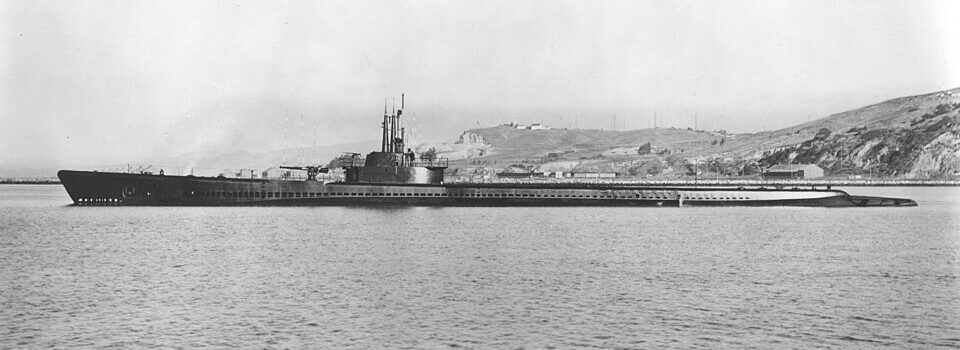
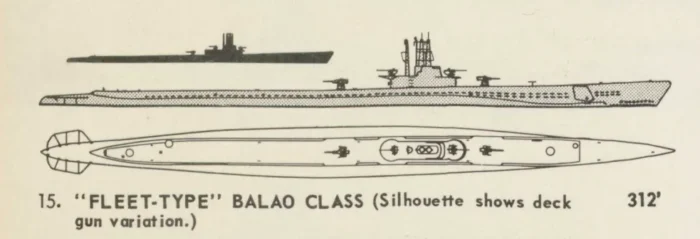


 Latest Facebook Entry -
Latest Facebook Entry -  X(Tweeter) Naval Encyclopedia's deck archive
X(Tweeter) Naval Encyclopedia's deck archive Instagram (@navalencyc)
Instagram (@navalencyc)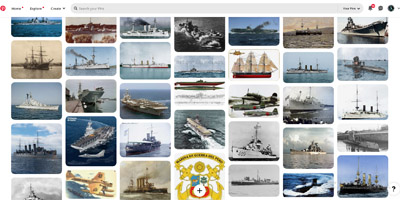

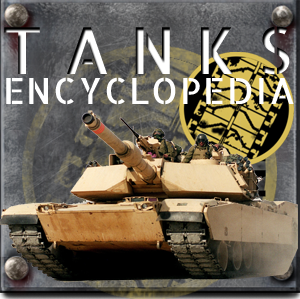
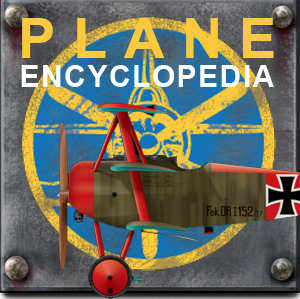
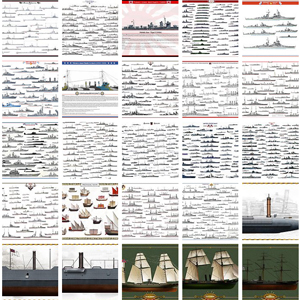
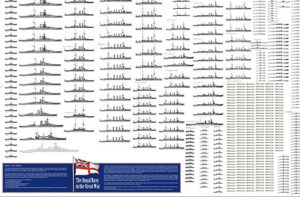
 French Navy
French Navy Royal Navy
Royal Navy Russian Navy
Russian Navy Armada Espanola
Armada Espanola Austrian Navy
Austrian Navy K.u.K. Kriegsmarine
K.u.K. Kriegsmarine Dansk Marine
Dansk Marine Nautiko Hellenon
Nautiko Hellenon Koninklije Marine 1870
Koninklije Marine 1870 Marinha do Brasil
Marinha do Brasil Osmanlı Donanması
Osmanlı Donanması Marina Do Peru
Marina Do Peru Marinha do Portugal
Marinha do Portugal Regia Marina 1870
Regia Marina 1870 Nihhon Kaigun 1870
Nihhon Kaigun 1870 Preußische Marine 1870
Preußische Marine 1870 Russkiy Flot 1870
Russkiy Flot 1870 Svenska marinen
Svenska marinen Søværnet
Søværnet Union Navy
Union Navy Confederate Navy
Confederate Navy Armada de Argentina
Armada de Argentina Imperial Chinese Navy
Imperial Chinese Navy Marinha do Portugal
Marinha do Portugal Mexico
Mexico Kaiserliche Marine
Kaiserliche Marine 1898 US Navy
1898 US Navy Sovietskiy Flot
Sovietskiy Flot Royal Canadian Navy
Royal Canadian Navy Royal Australian Navy
Royal Australian Navy RNZN Fleet
RNZN Fleet Chinese Navy 1937
Chinese Navy 1937 Kriegsmarine
Kriegsmarine Chilean Navy
Chilean Navy Danish Navy
Danish Navy Finnish Navy
Finnish Navy Hellenic Navy
Hellenic Navy Polish Navy
Polish Navy Romanian Navy
Romanian Navy Turkish Navy
Turkish Navy Royal Yugoslav Navy
Royal Yugoslav Navy Royal Thai Navy
Royal Thai Navy Minor Navies
Minor Navies Albania
Albania Austria
Austria Belgium
Belgium Columbia
Columbia Costa Rica
Costa Rica Cuba
Cuba Czechoslovakia
Czechoslovakia Dominican Republic
Dominican Republic Haiti
Haiti Hungary
Hungary Honduras
Honduras Estonia
Estonia Iceland
Iceland Eire
Eire Equador
Equador Iran
Iran Iraq
Iraq Latvia
Latvia Liberia
Liberia Lithuania
Lithuania Mandchukuo
Mandchukuo Morocco
Morocco Nicaragua
Nicaragua Persia
Persia San Salvador
San Salvador Sarawak
Sarawak Uruguay
Uruguay Venezuela
Venezuela Zanzibar
Zanzibar Warsaw Pact Navies
Warsaw Pact Navies Bulgaria
Bulgaria Hungary
Hungary

 Bundesmarine
Bundesmarine Dutch Navy
Dutch Navy Hellenic Navy
Hellenic Navy Marina Militare
Marina Militare Yugoslav Navy
Yugoslav Navy Chinese Navy
Chinese Navy Indian Navy
Indian Navy Indonesian Navy
Indonesian Navy JMSDF
JMSDF North Korean Navy
North Korean Navy Pakistani Navy
Pakistani Navy Philippines Navy
Philippines Navy ROKN
ROKN Rep. of Singapore Navy
Rep. of Singapore Navy Taiwanese Navy
Taiwanese Navy IDF Navy
IDF Navy Saudi Navy
Saudi Navy Royal New Zealand Navy
Royal New Zealand Navy Egyptian Navy
Egyptian Navy South African Navy
South African Navy






























 Ukrainian Navy
Ukrainian Navy dbodesign
dbodesign